Flower (tree) (plant) symbolism (meanings) chart (full info) | What is beauty flower symbol? | Which flower means good luck (Secret love)? | Rose flower symbolism chart | Flower symbolism chart tattoo (list) | Pink, Purple, Blue flower symbolism chart | Flower meaning love
Hello friends, how are you doing today? Welcome to #Relationships-Parenting website / blog.
Let you and your well-wishers live a happy and prosperous life through out your life term.
In this website / blog, you will always learn about #Relationships #Parenting.
Also subscribe / follow to our various social media networks from here to learn more about #Relationships #Parenting:
Just before going to “Flower (tree) (plant) symbolism (meanings) chart (full info) | What is beauty flower symbol? | Which flower means good luck (Secret love)? | Rose flower symbolism chart | Flower symbolism chart tattoo (list) | Pink, Purple, Blue flower symbolism chart | Flower meaning love“, let us know a brief, basic and very important information.
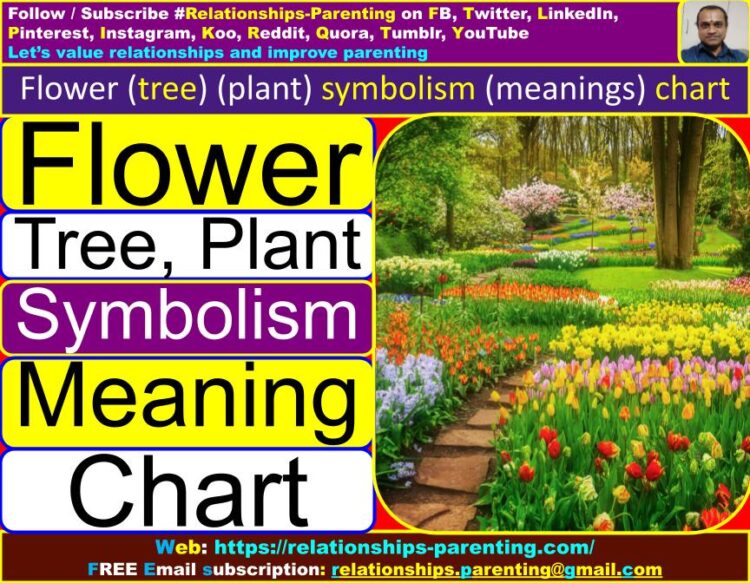
Few of the common questions asked regarding this subjects is as given below:
What do some flowers symbolize | What flower represents life | What flowers mean goodbye | What emotion do flowers represent | What do the 7 flowers mean | What flowers teach us about life |
What flower means forever | What flower represents true love | What flower means hope | Flower symbolism list | Plant symbolism | Flower language list |
Flower meaning love | What does flower symbolize in life | Flower meaning family | Flower meaning strength | And many more…
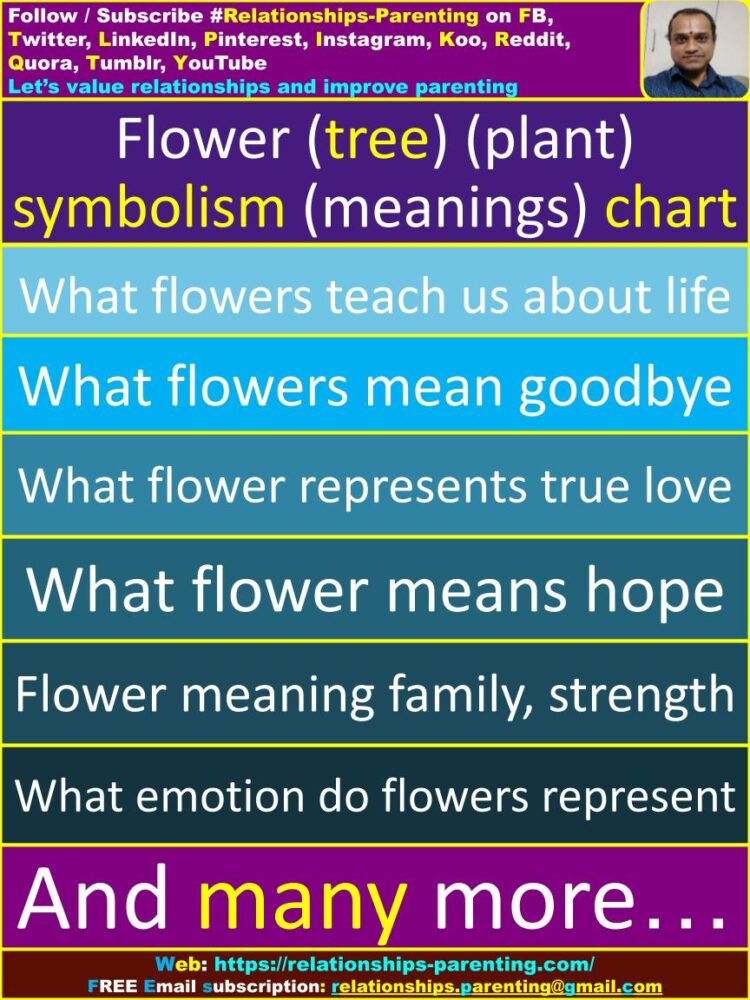
What is a flower : A flower, something that blossoms or blooms, is a reproductive structure found in flowering plants and trees.
Rose as per Shakespeare : Shakespeare had once said that he believed roses were the best of flowers, “Of all flowers, methinks rose is best.”
Origin of flowers : About 300+ million years ago, before the end of the Carboniferous, the ancestors of flowering plants diverged from the common ancestor of all living gymnosperms. The origin and closest fossil relatives of flowering plants are so far uncertain.
The history of flowers : The language of flowers has been recognized for centuries in many countries throughout Asia and Europe. Flowers play a large and important role in the works of great poets, myths, folklore, sonnets and plays of ancient Indians, Greeks, Romans, Egyptians and Chinese.
Whether you are giving flowers to mother on Mother’s Day or to a friend on their birthday or to a lover on Valentine’s Day, every emotion imaginable can be expressed with flowers.
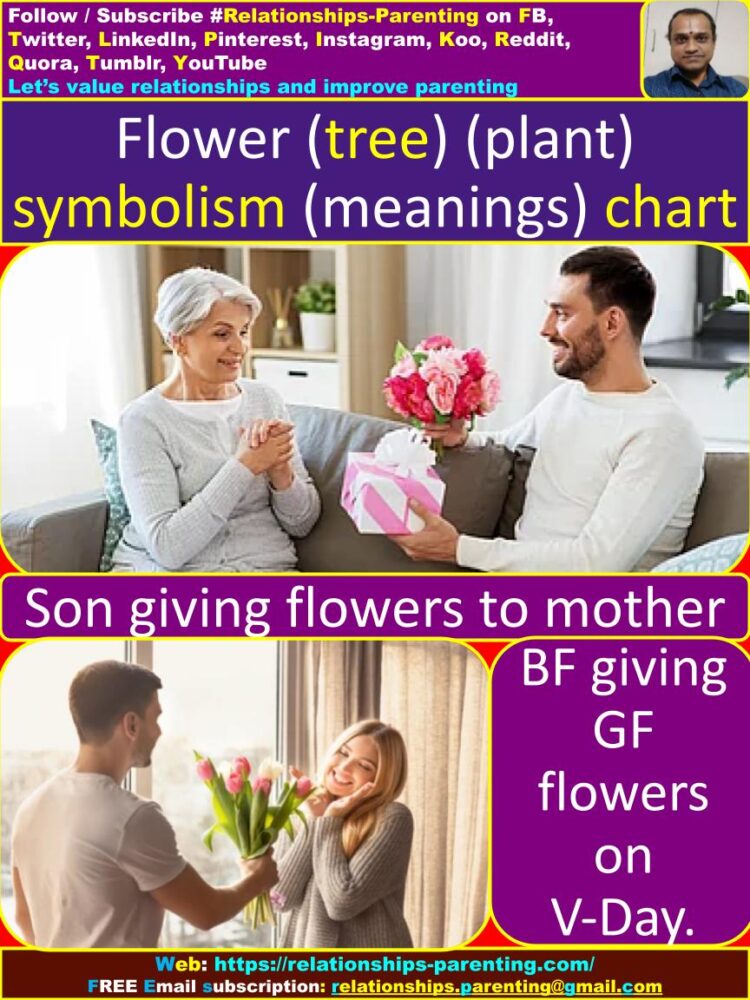
Flowers play a central role in the worship (puja) of gods in Hinduism. There is no festival in India without flowers. A red chrysanthemum means “I love you”, while an orange flower means chastity, purity and beauty. In this post let’s know different flowers which has different meanings.
List of the rose symbolism chart is as given below:
White rose : Purity, innocence, virginity, righteousness, morality, decency. reverence, a new beginning, a fresh start.
Red rose : For love, fondness, admiration, devotion, adoration, worship. To tell that you love someone, “I love you”.
Pink rose : Grace, elegance, poise, charm, courtesy, respect, blissfulness, gentleness, kindness, tenderness, carefulness, caution. Yellow rose : Jealousy, envy, discontent, bitterness, grudge, resentment, spite, infidelity.
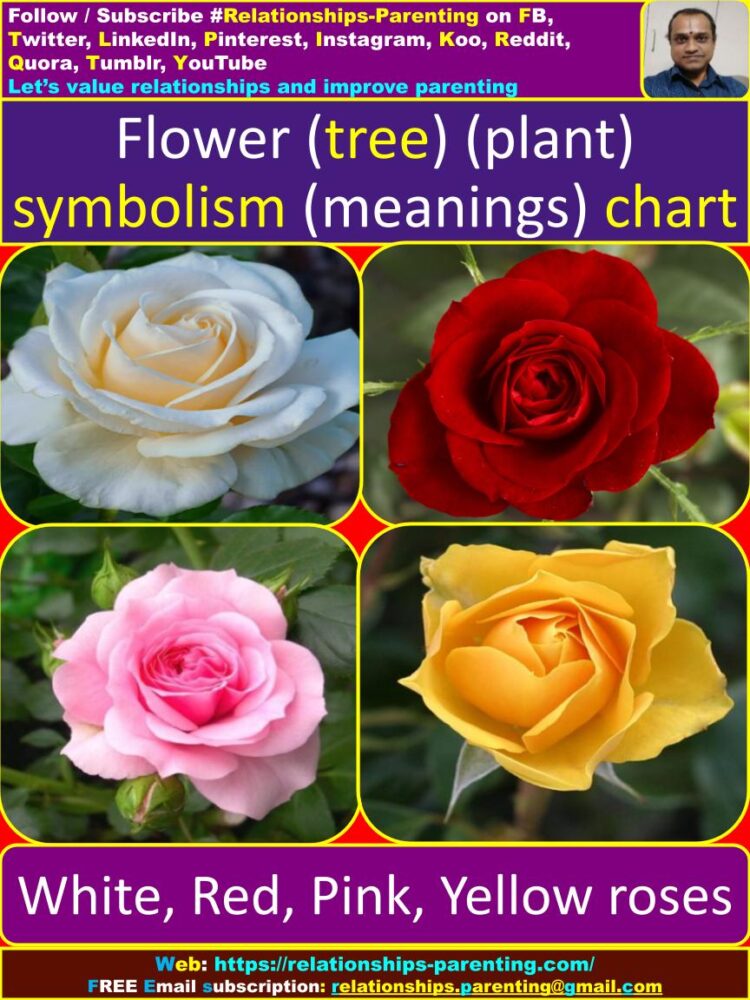
Orange rose : Desire, eagerness, keenness, ardor, fervor, warmth, passion, zeal, zest, vivacity, enthusiasm. Lavender rose : Love at first sight, eye-to-eye contact, eye gaze, locking of eyes, looking one in the eye, shared eye gaze, meeting of the eyes, looking into each other’s eyes, mutual gaze.
Coral rose : Friendship, amity, closeness, chumship (dated), fellowship, friendhood, mateship, modesty, sympathy.
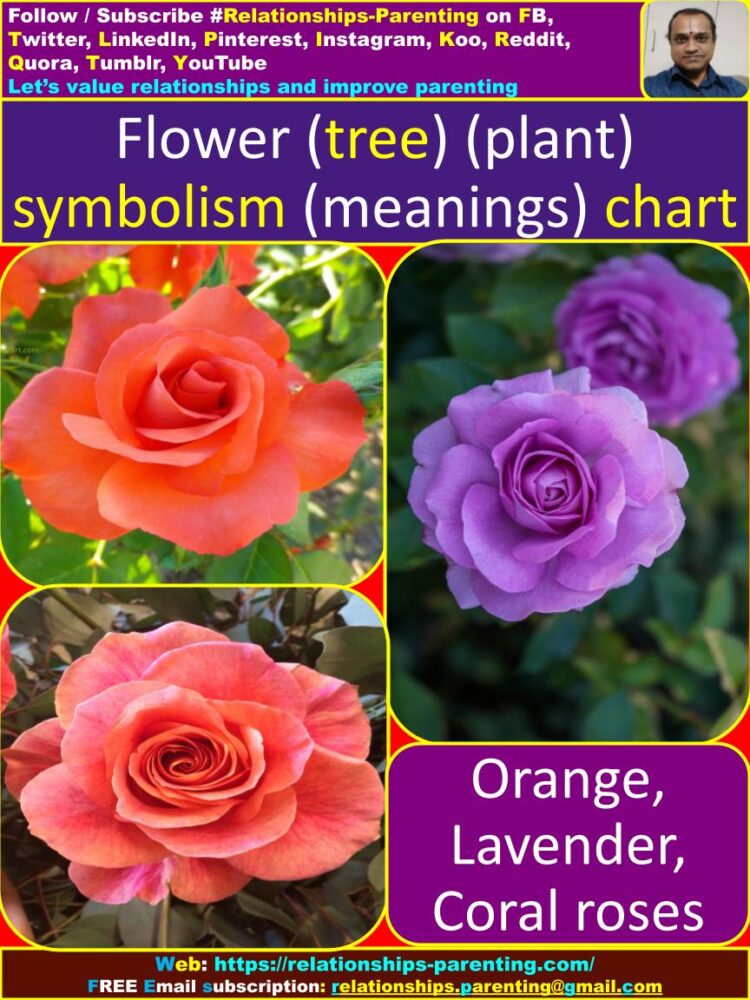
1 rose : Just one rose, but it is for “Love at first sight”. This is direct eye-to-eye contact of both man and woman.
2 roses : Two roses, it is all about “Love and affection”. This is about fondness, liking, care, closeness, warmth, feeling, etc.
3 roses : Usually given as a gift for a one-month anniversary. A bouquet of three roses means “I love You” and is the traditional one-month anniversary gift. 6 roses : You’re infatuated and want the recipient to be yours. This is to say “I miss you”.
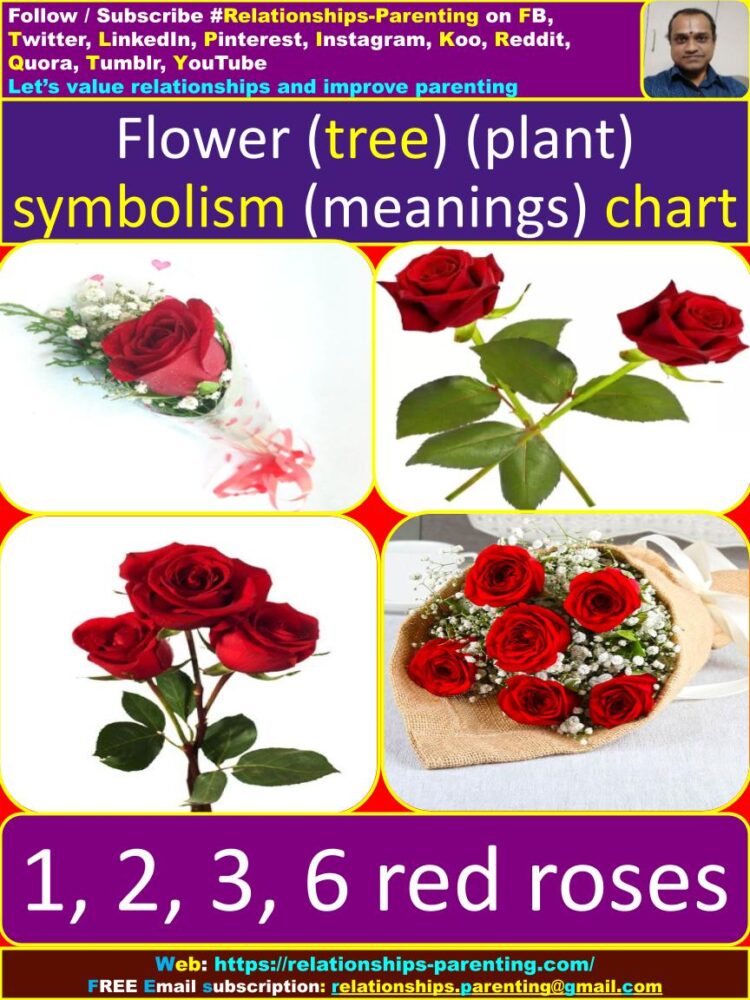
7 roses : Whether it’s a new crush or familiar one, seven roses symbolize infatuation, passion, desire, crush, etc.
9 roses : To send the message “We’ll be together forever, eternally, until the word ends, until doomsday, ceaselessly” give a bouquet of nine roses.
10 roses : This is tell someone that their love is perfect, flawless, ultimate, exemplary, exquisite with a bouquet of ten roses. 12 roses : This is a classic bouquet size to ask someone to be yours. A perfect dozen exclaims “Be mine!”
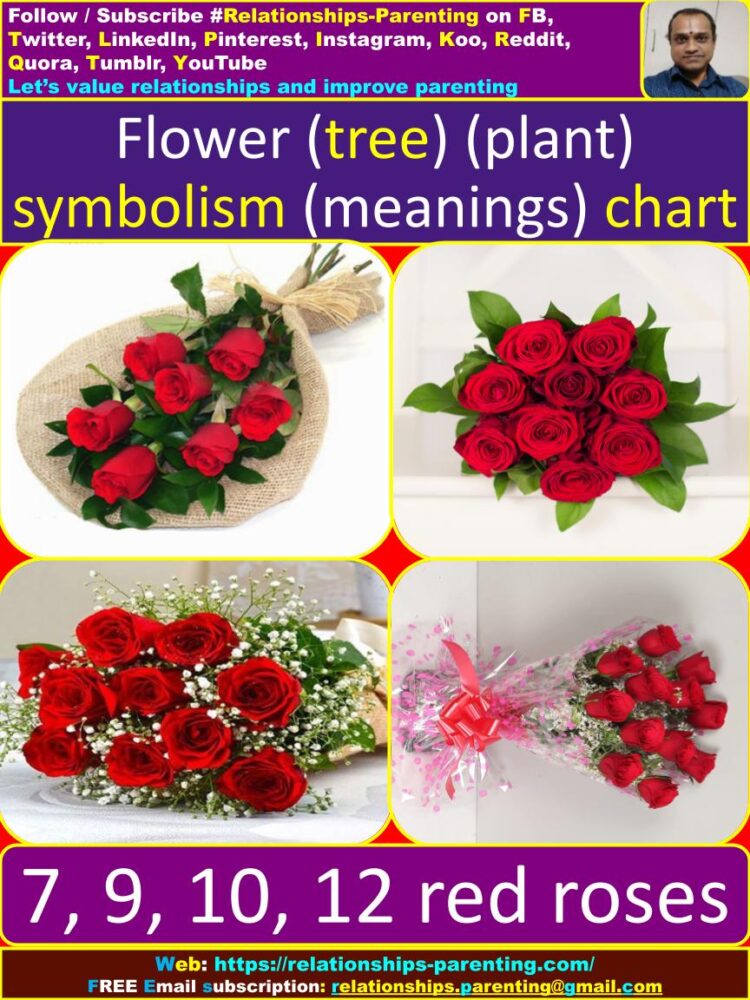
13 roses : A baker’s dozen means a secret admirer, secret lover, anonymous lover, mystery worshiper is waiting to be revealed.
15 roses : Give 15 roses to say sorry, regret. “Oh darling, please excuse me for all my faults”.
21 roses : Declare your dedication, commitment, enthusiasm, diligence, loyalty, devotion with twenty-one roses. 24 roses : This huge bunch of roses simply says ‘I’m yours forever’. Two dozen roses confirm “I’m yours!”
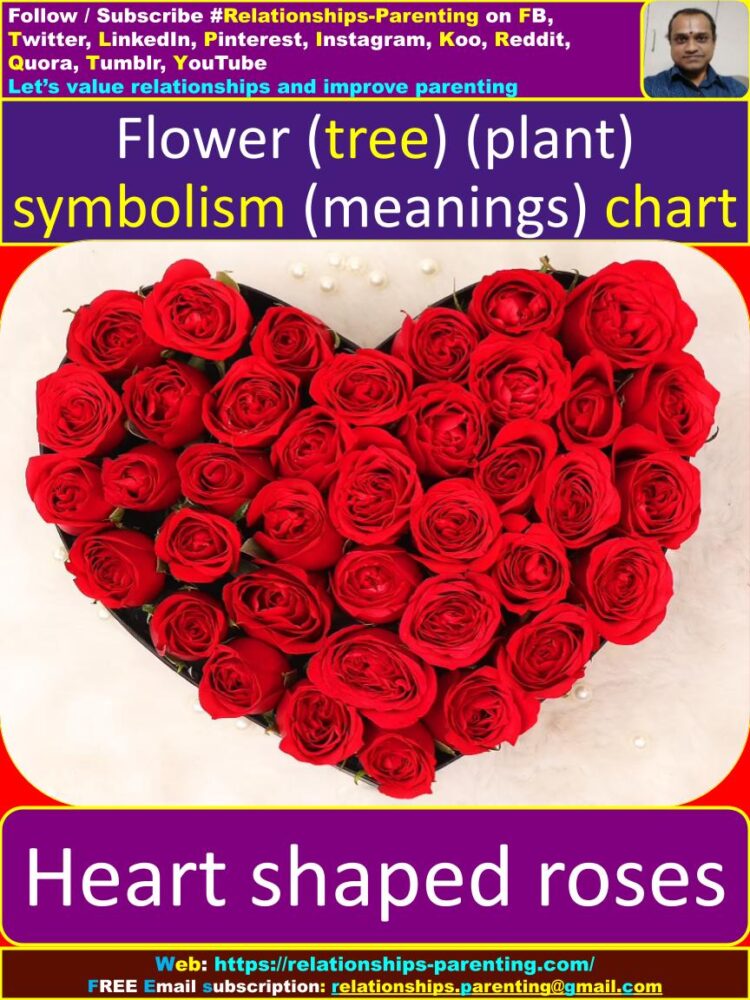
25 roses : Send a message of congratulations, good wishes, greetings, praise, honor, acclamation, cheers, ovation, laurels with twenty-five roses. 36 roses : When you’re head over heels in love, say so with three dozen roses.
40 roses : Forty roses say, “My love for you is genuine, authentic, bona fide, unadulterated, legitimate, undisputed, original.”
50 roses : That’s a lot of roses! This is the ultimate romantic bouquet when you want to make an impression. Express a love that knows no bounds with a bouquet of fifty.
100 roses : This grand statement suggests that your love is in bountiful supply and will last eternally. 108 roses : Pop “the question” with 108 roses!
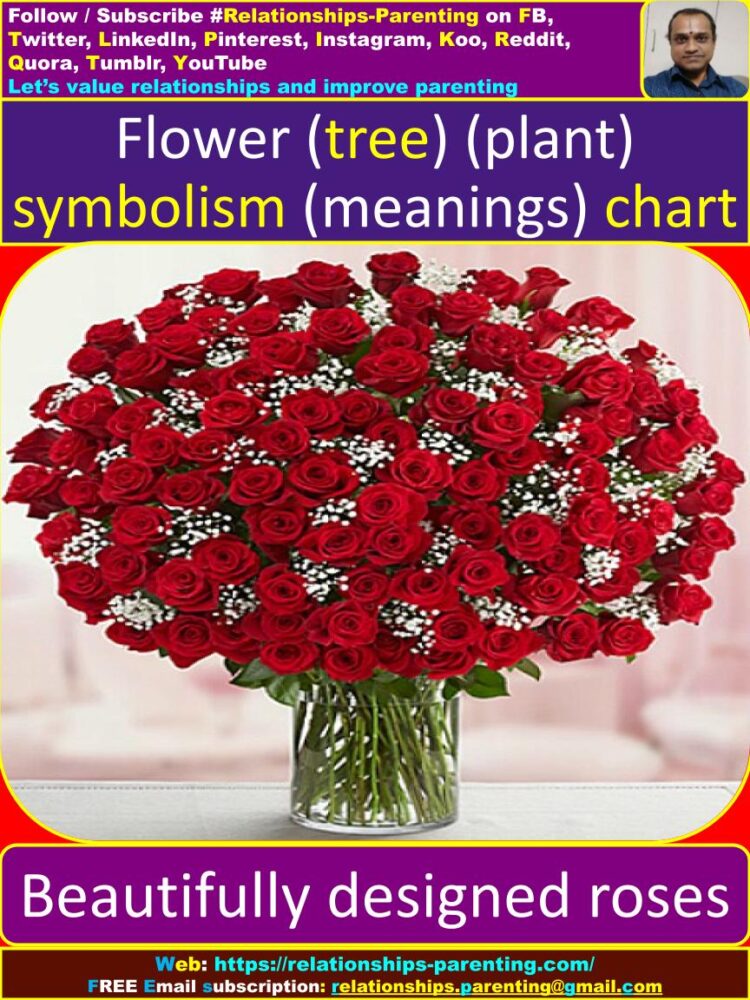
List of the flower (tree) (plant) symbolism (meanings) chart is as given below:
Bay tree : This tree’s flower symbolizes glory, renown, fame, prestige, honor, distinction, eminence, acclaim, celebrity, etc. The bay tree is frequently mentioned in ancient Greek mythology.
Symbolizing courage and strength, this beautiful, evergreen tree was also treasured by the Roman gods, who wore bay shoots as crowns to represent their high status and glory.
Edelweiss : This plant symbolizes courage, audacity, bravery, daring, determination, endurance, fearlessness, firmness, fortitude, lion-heartedness, etc.
Similarly this plant also symbolizes devotion, loyalty, faithfulness, fidelity, trueness, staunchness, steadfastness, constancy, etc.
The German word ‘Edelweiss’ or ‘Edelweiss’ is a combination of ‘Edel’ meaning noble, and ‘Weiss’ meaning white. Edelweiss flower has a devotional meaning.
The symbol of devotion stems from the fact that the Edelweiss flower grows in some of the harshest alpine conditions in the world.
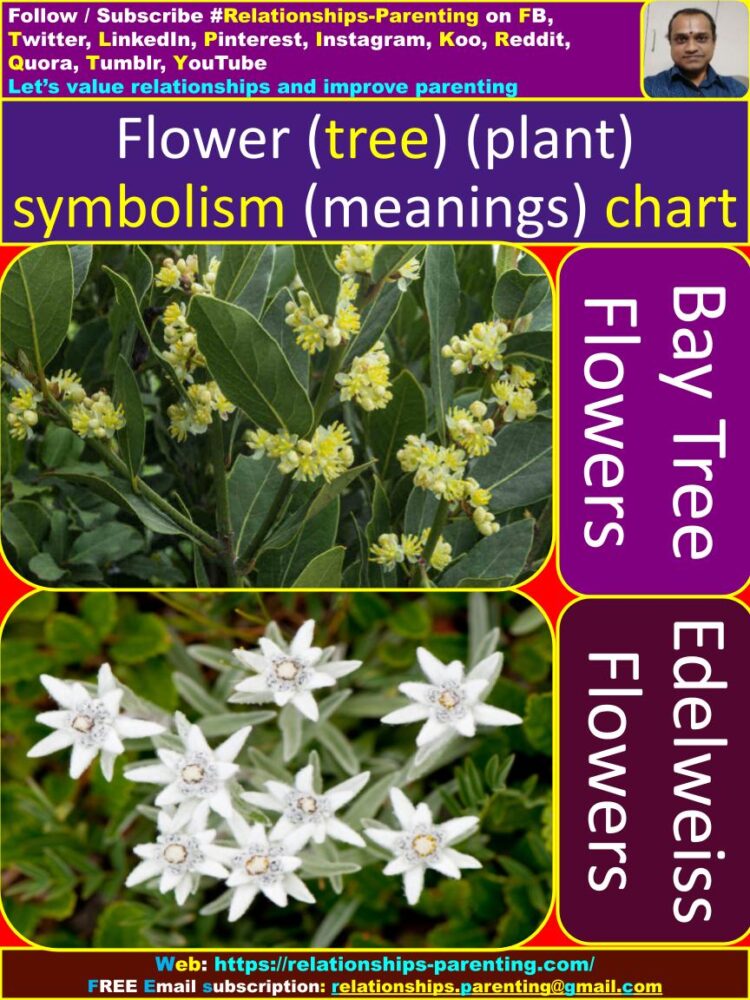
Speedwell : This plant symbolizes feminine fidelity, loyalty, allegiance, obedience, constancy, fealty, homage, staunchness, accuracy, exactness, precision, correctness, etc.
Speedwells are considered lucky charms by travelers whose vision is fast moving. Veronica, a surname, probably derives from the Latin adjective vera- meaning true and -nica meaning image.
Dahlia : This plant symbolizes good taste, adequate, common, decent, fair, respectable, sufficient, tolerable, admissible, alright, average, cool, etc.
During the Victorian era, when floriography (the language of flowers) was all the rage, dahlias were offered as symbols of devotion, love, beauty and dignity.
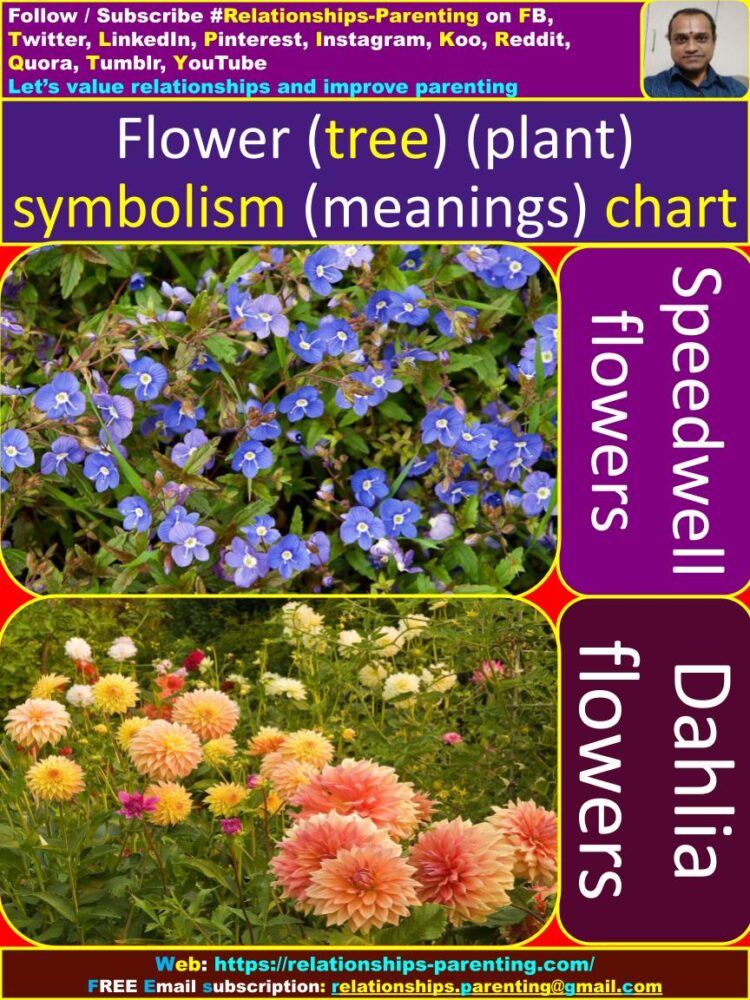
Abatina : This flower symbolizes fickleness, variability, volatility, vacillation, fitfulness, irregularity, undependability, inconstancy, instability, unsteadiness, impulsiveness, unpredictability, unpredictability, randomness, lability, etc.
Abatina appears to be an archaic or misunderstood reference to an unidentified flower. It first appears in Kate Greenaway’s anthology The Language of Flowers and has been propagated without further recognition in later literature.
Baby’s Breath : This flower symbolizes everlasting love, eternal, never-ending, endless, without end, perpetual, undying, immortal, deathless, indestructible, immutable, abiding, enduring, infinite, etc.
Baby’s breath symbolizes eternal love and innocence. No wonder it’s a popular and favorite among wedding bouquets.

Zinnia : This flower symbolizes thoughts of absent friends, lasting affection, eternal, endless, immortal, indestructible, perpetual, timeless, undying, etc.
Zinnias stand as a reminder to never forget absent friends and lasting affection, so send a distant friend a bouquet today or get them a flower subscription.
Hydrangea : This flower symbolizes gratitude for being understood, thanks, appreciation, recognition, acknowledgement, hat tip, credit, regard, respect, etc. Hydrangea represents gratitude, grace and beauty.
It radiates prosperity due to its lavish number of flowers and generous round shape. Its colors symbolize love, harmony and peace.
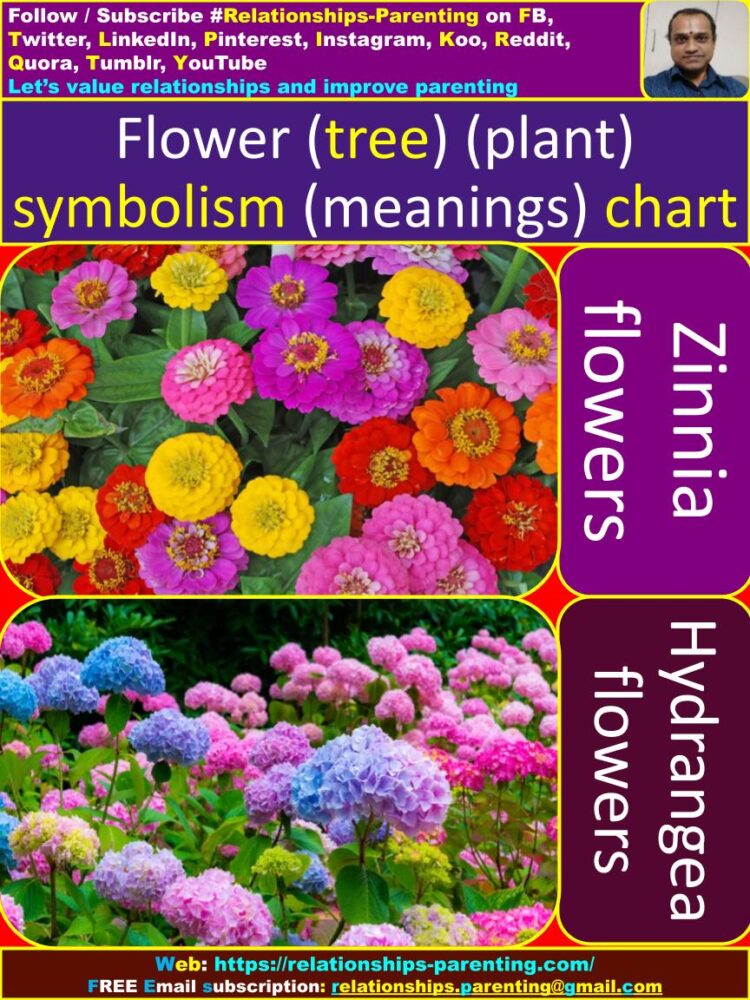
Chamomile : This flower symbolizes patience in adversity, forbearance, tolerance, restraint, self-restraint, stoicism, fortitude, endurance, calmness, composure, equilibrium, serenity, etc.
Chamomile plants are a symbol of rest and relaxation. However, flowers were used to denote ‘strength in adversity’ in the late 19th century. That means people who are getting ready to face the day drink chamomile tea in the morning.
Geranium : This flower symbolizes folly, stupidity, insanity, idiocy, absurdity, madness, imbecility, foolery, etc.
Geraniums are said to symbolize positive things like good health, friendship and happiness. In many regions, they are common household gifts for these reasons.
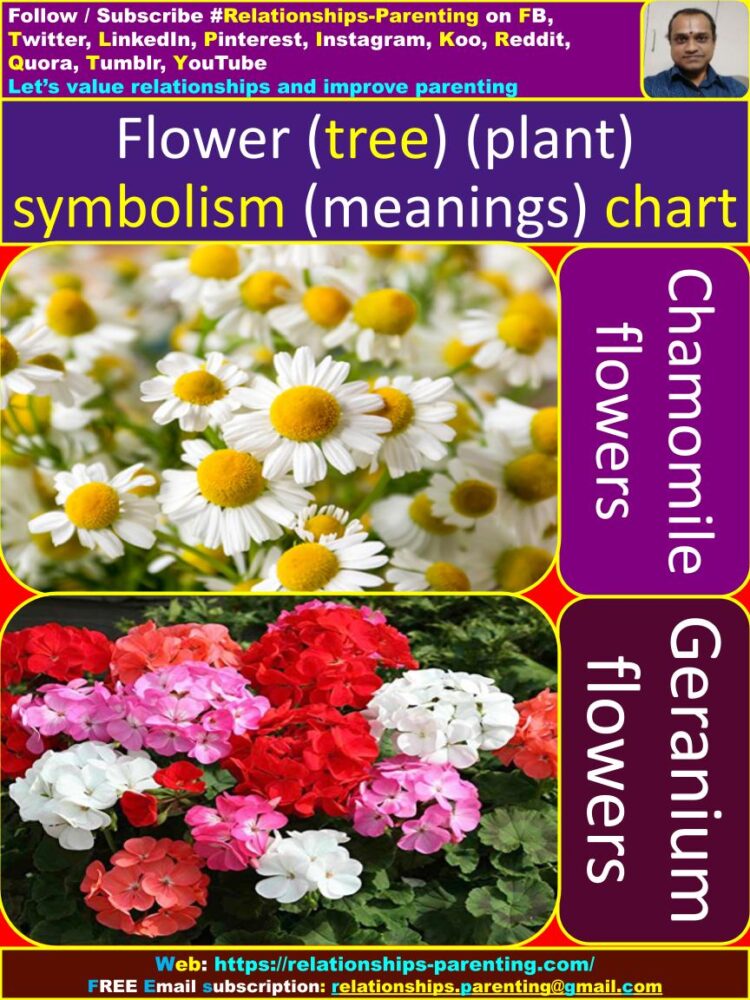
Marigold : This flower symbolizes Grief, sorrow, misery, sadness, anguish, pain, jealousy, envy, desire, resentment, resentfulness, bitterness, discontent, etc.
Marigolds are often associated with the powerful energy of the sun and represent the energy, strength and light that resides within a person.
Marigold has also come to symbolize the feeling of hopeless love. If anyone has lost a loved one, be it through death or a broken relationship.
Butterfly weed : This symbolizes loneliness, isolation, friendlessness, forsakenness, abandonment, rejection, unpopularity, sadness, unhappiness, lonesomeness, solitude, lack of company, etc. Butterfly weed and daffodils often symbolize loneliness. Butterfly flower means to leave or leave someone.
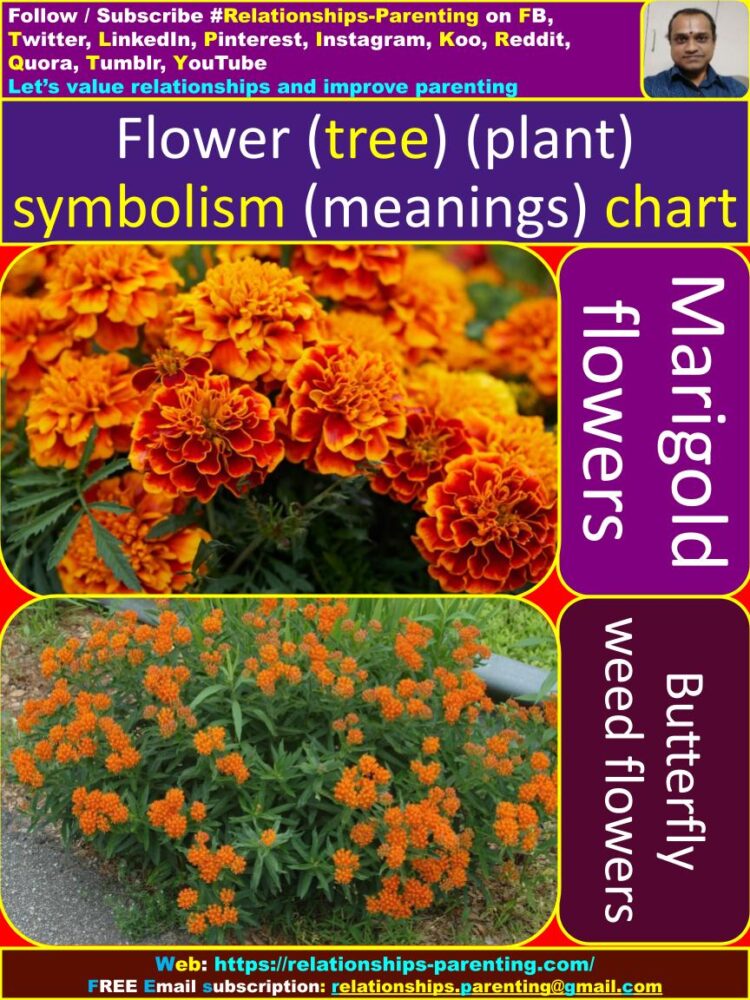
Tarragon : This flower symbolizes lasting interest, ardor, fervor, passion, vigor, fervor, fondness, keenness, zeal, etc. If you are looking for passion filled love, you can gift this to your opposite sex.
Lilac : This flower symbolizes joy of youth, freshness, youngness, prime, youth, adolescence, immaturity, juvenility, minority, etc.
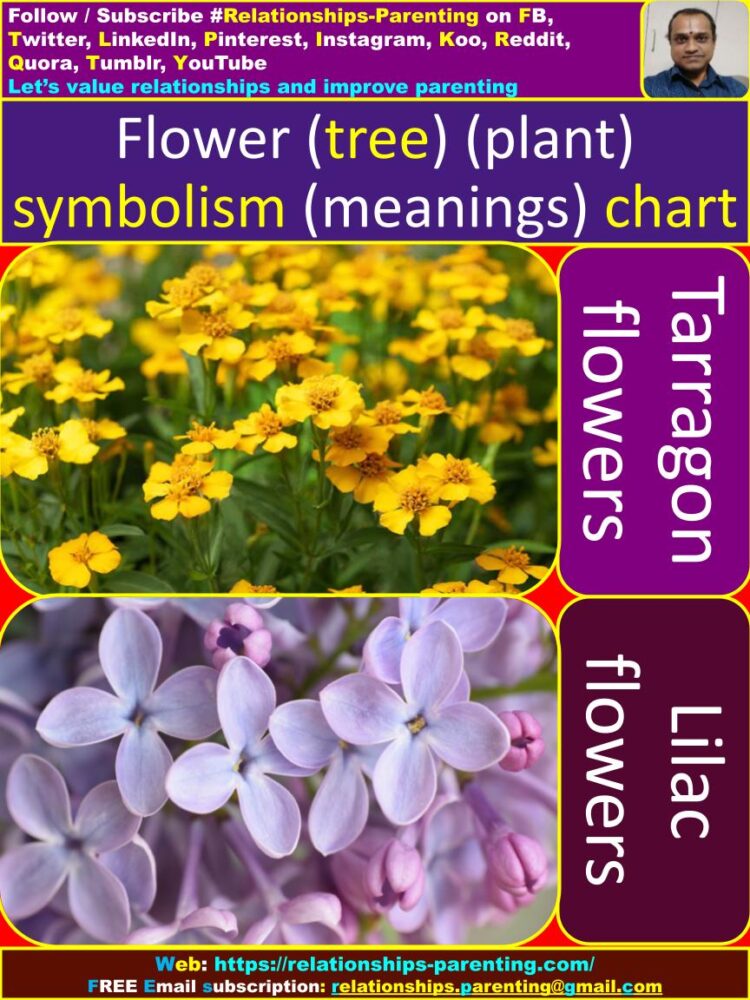
Lily (white) : This flower represents virginity, respectability, dignity, modesty, purity, honour, honesty, integrity, uprightness, heavenly, devotion, etc.
Usually chosen for both weddings and funerals, white lilies symbolize the rejuvenation of the soul. They can represent purity, commitment and rebirth, and for this reason it is often chosen as sympathy flowers.
Lily (yellow) : This flower symbolizes happy, propitious, felicitous, auspicious, beneficial, helpful, feel elated, jubilant, prideful, rejoicing, triumphal, triumphant, etc.
Yellow lilies make great ‘thank you’ flowers. They symbolize gratitude and their sunny color evokes feelings of happiness that will put a smile on your loved one’s face.
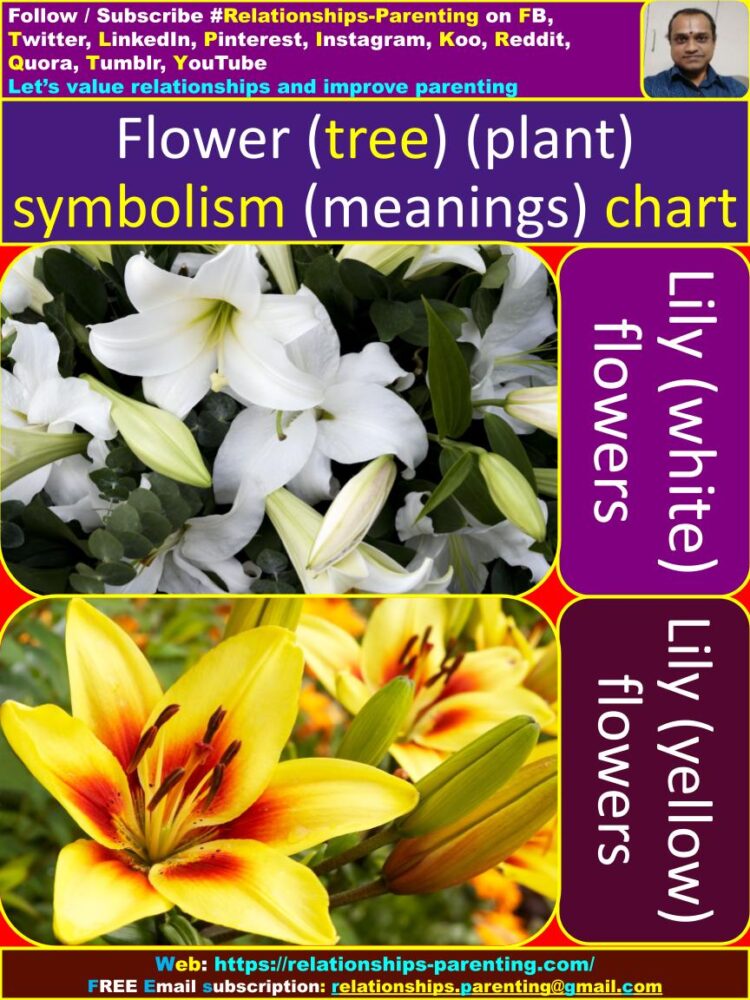
Lily (orange) (tiger) : This flower symbolizes hatred, loathing, detestation, dislike, distaste, abhorrence, abomination, execration, aversion, hostility, ill will, etc.
Here is one of the flowers that have the meaning of good and bad. The orange lily reflects both passionate desire and hatred.
Lily of the valley : This flower symbolizes sweetness, humility, pleasantness, agreeability, amiableness, geniality, affability, agreeableness, amiability, etc. The lily of the valley flower has long been associated with royalty and is used as a symbol of love, motherhood and purity.
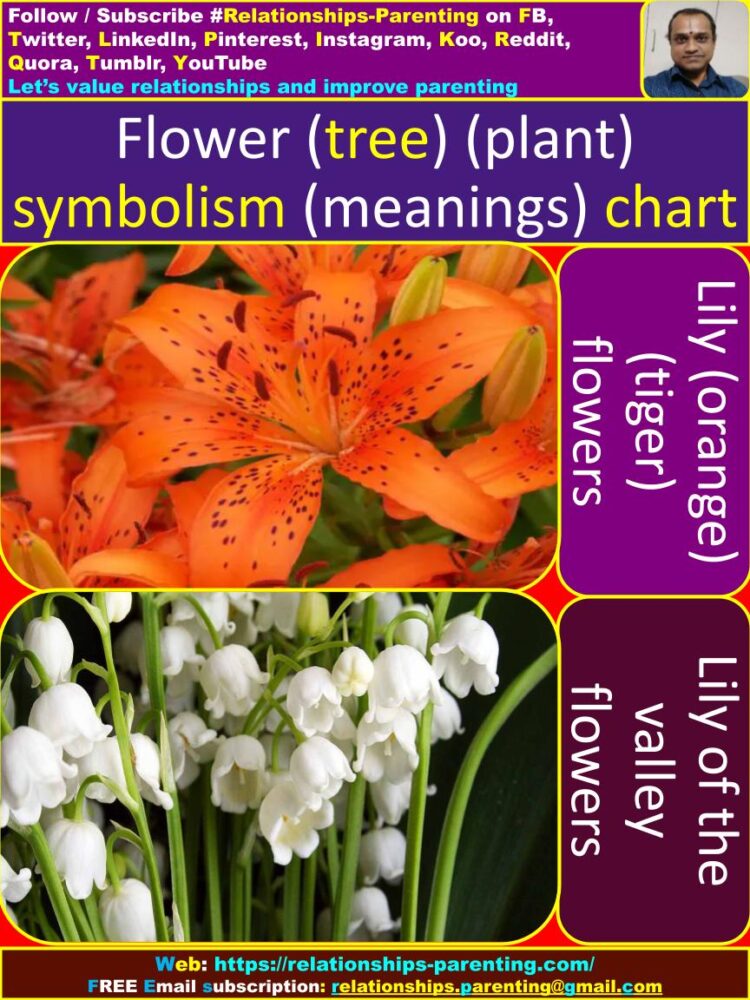
Acanthus : This flower symbolizes the fine art, artifice, craft, etc. The acanthus is a botanical motif rich in symbolism and has long been associated with the idea of rebirth.
It is a symbol of immortality and resurrection, and as a decorative motif it has been used in Greek art as early as 500 BCE.
Hyacinth : This flower represents sport, competitiveness, game, physical activity, play, flaunting, flourishing, etc.
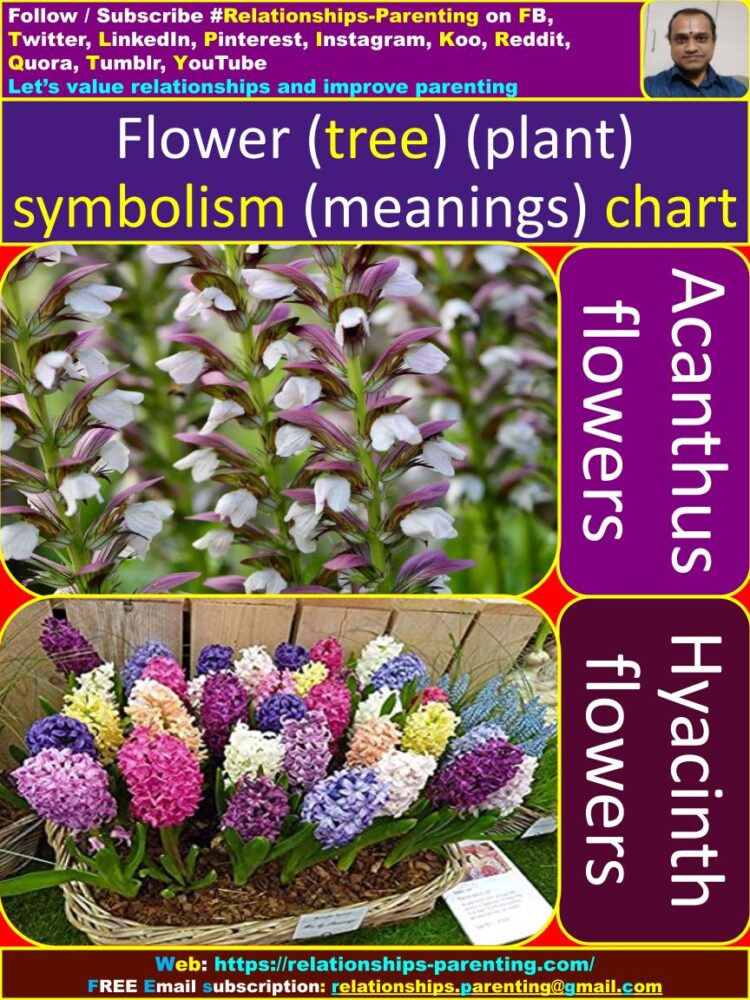
Hyacinth (blue) : This flower shows the constancy, fidelity, faithfulness, loyalty, trueness, commitment, dedication, devotion, dependability, reliability, etc. Apollo named the flower that grew from the hyacinth as blood hyacinth.
Symbolizing sport or play in the language of flowers, the hyacinth represents stability, while the blue hyacinth expresses sincerity.
Hyacinth (purple) : This flower represents sorrow, sadness, unhappiness, dejection, regret, depression, misery, cheerlessness, downheartedness, despondency, despair, etc. Purple Hyacinth Meaning: Sadness, “sorry forgive me”.
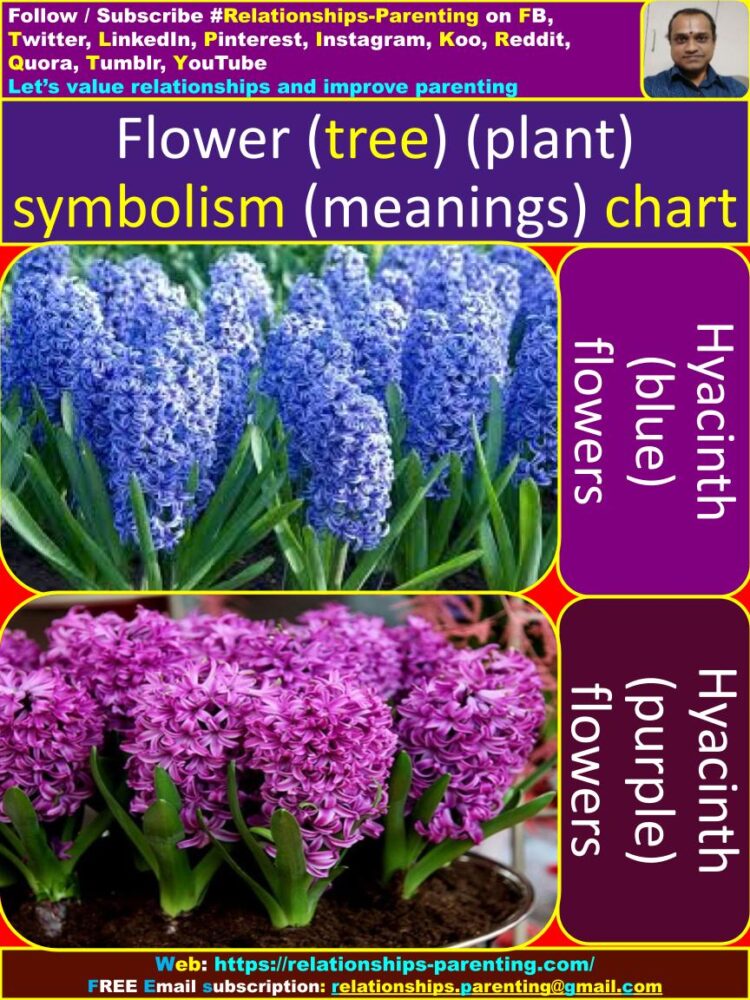
Hyacinth (yellow) : This flower talks about jealousy, envy, covetousness, desire, resentment, bitterness, discontent, spite, grudge, etc.
Hyacinths symbolize jealousy, desire for forgiveness, happiness and honesty, depending on the color of the flower. Yellow hyacinths are associated with jealousy.
Hyacinth (white) : This flower represents loveliness, beauteousness, comeliness, fairness, prayers for someone, etc.
These flowers symbolize deep thoughts for others, in pure form. They’re a great way to let someone know you’re wishing them well during a big life transition or challenging time.
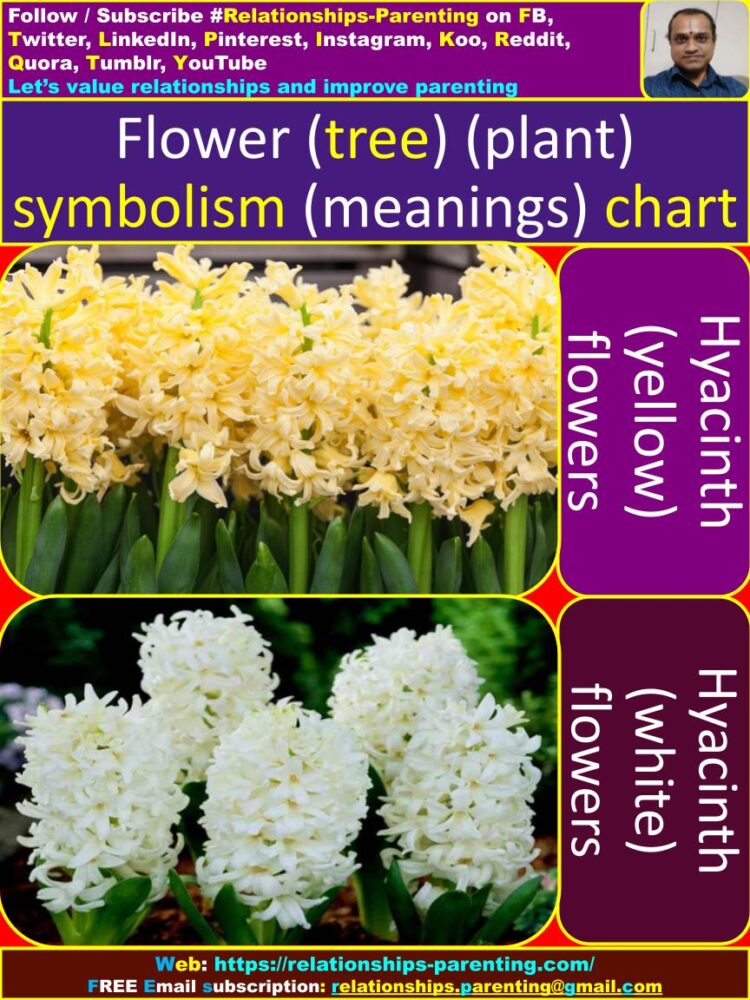
Aloe : This flower tells us about affection, fondness, love, liking, endearment and similarly about grief, sorrow, misery, suffering, etc. Aloevera flower is a revered symbol of beauty, good luck and good health.
The flower blooms only 3-4 months a year from early spring to late summer, symbolizing patience and endurance.
Basil : This plant has very high importance in Hinduism. This plant teaches about good wishes, compliments, felicitations, greetings, hail, best wishes, give a ‘hear-hear’, good going, good work, etc.
Basil is a highly tasty little plant, but it has suffered a symbolic identity crisis over the years. In the Victorian era, sweet basil conveyed “good wishes” to the recipient.
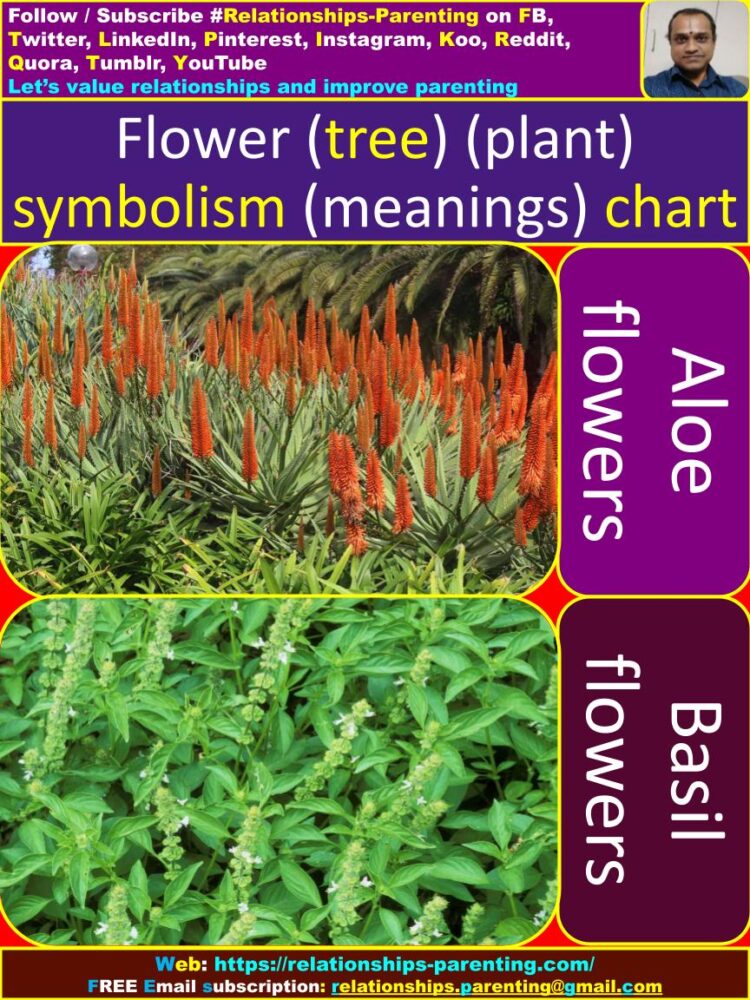
Hyssop : This flower talks about sacrifice, oblation, surrender, foregoing, renouncing and also about cleanliness, freshness, purity, etc. In the flowers language, the hyssop flower is a traditional symbol of humility, repentance, health and sacrifice.
Carnation : This flower represents fascination, interest, preoccupation, enchantment, charm, attraction, female love, mother’s love, etc.
The carnation flower symbolizes love, captivation and distinction and it is no wonder that it is widely used today and is an excellent alternative to rose bouquets. It makes a beautiful addition to any group because of its long-lasting freshness and fragrance.

Carnation (red) : This flower talks about the poor heart, heartaches, deep love, affection, respect, etc.
A rich red carnation symbolizes deep love and affection, while a pale red carnation represents admiration and “my heart aches for you”. The deep red petals of a red carnation are said to represent a heart full of love!
Carnation (white) : This flower represents innocence, clean mind, pure love, sweet love, dearest, most beloved, etc.
White carnations often have thoughts of purity and sweetness. When given on Mother’s Day, they are said to bring good luck to the mother. Some carnation petals are solid colors while others are striped.
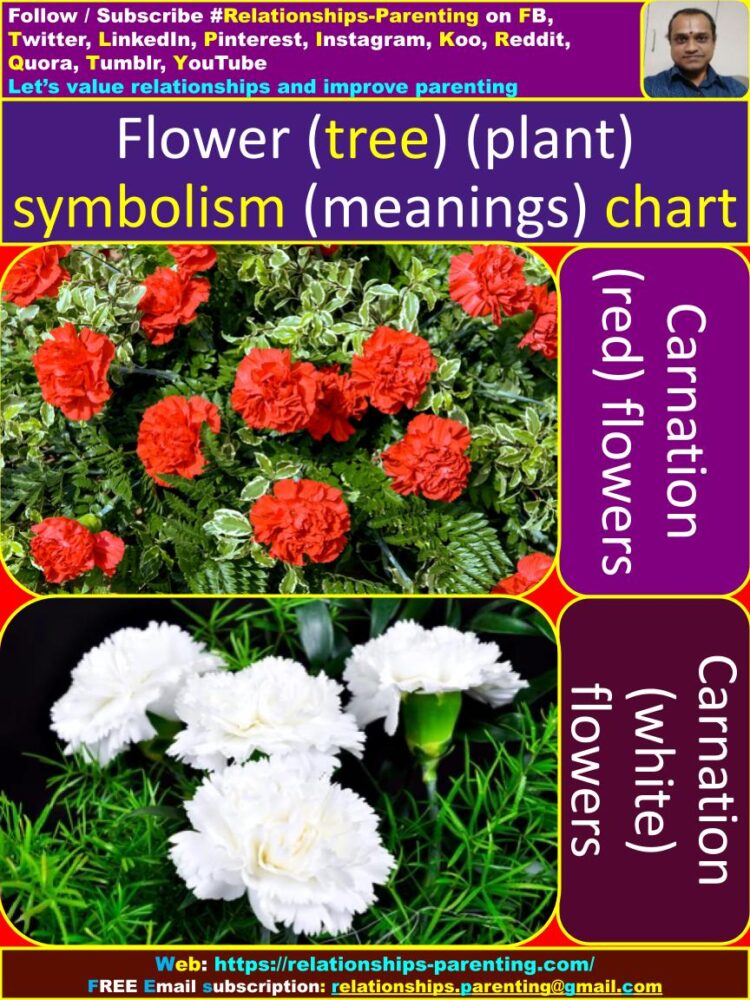
Carnation (pink) : This flower tells about I’ll never forget you, long lasting, eternal, forever, etc. A pink carnation is given as a token of heartfelt gratitude to say “thank you” and “I will never forget you”. Light pink carnations represent love and gratitude, like a mother.
Carnation (striped) : This flower represents refusal, non-acceptance, regrets, turndown, denial, etc. Solid colors of carnation flowers mean a firm “yes”, giving a striped carnation means a refusal or “no”.
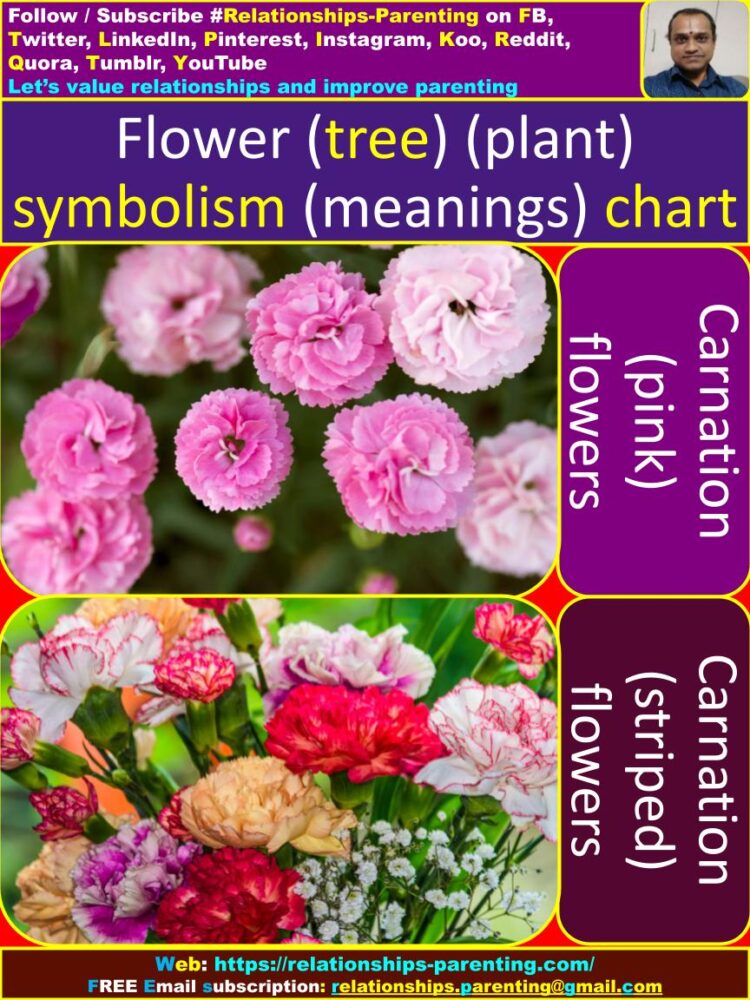
Carnation (yellow) : This flower tells about disdain, disrespect, haughtiness, arrogance, disappointment, rejection, etc.
A yellow carnation expresses a feeling of more sadness and portrays the idea of rejection or disappointment towards someone.
Yarrow : This flower represents everlasting love, eternal love, forever love, immortal love, undying love, etc. Yarrow is bold, brave and a symbol of saying I love you in spite of everything. Achillea comes from Achilles, the warrior hero of the Trojan saga.

Spearmint : This flower tells about warmth of sentiment, enthusiasm, excitement, passion, affection, friendliness, hospitality, kindness, sincerity, sympathy, etc.
Spearmint is named after a species of mint plant and is most closely associated with chewing gum.
As a green tone, spearmint is earthy and cool, representing freshness, wellness, nature, balance, safety, rebirth and renewal.
Goldenrod : This flower represents encouragement, cheering, uplifting, inspiration, motivation, good fortune, etc. Goldenrods represent encouragement and development. Often offered in times of grief and loss, goldenrods are a symbol of positivity and support.
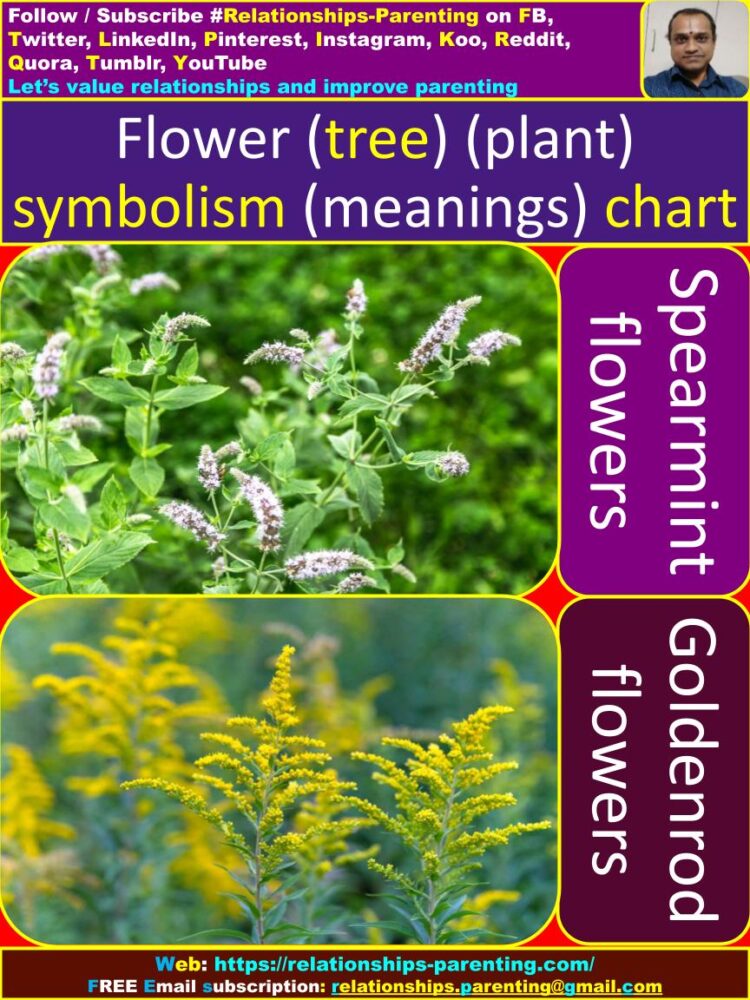
Oak : This flower talks about strength, power, muscularity, toughness, vigor, energy, force, etc.
From the earliest relationships between humans and oaks, a very strong symbolic image of oaks developed, in which these trees were associated with longevity, stability, endurance, fertility, justice and honesty.
Willow : This flower tells about sadness, unhappiness, dejection, regret, depression, gloominess, grief, etc. The willow tree symbol represents both loss and hope. This signifies the long-term rebirth and vitality of the willow tree.

Iris : This flower represents about faith, belief, trust, wisdom, intelligence, hope, valor, aspiration, etc. They can represent faith, hope, courage, wisdom and appreciation. Specific flower colors add further meanings to beautiful flowers.
Purple iris brings a message of wisdom and congratulations, while a bouquet of blue iris flowers speaks of hope and belief.
Columbine : This flower tells about foolishness, stupidity, idiocy, recklessness, madness, thoughtlessness, folly, etc.
Columbine serves as a symbol of fortitude and is sometimes given as a gift to provide courage and endurance in one’s endeavors. Whatever meaning you attribute to this flower, columbine can make a beautiful addition to your garden.
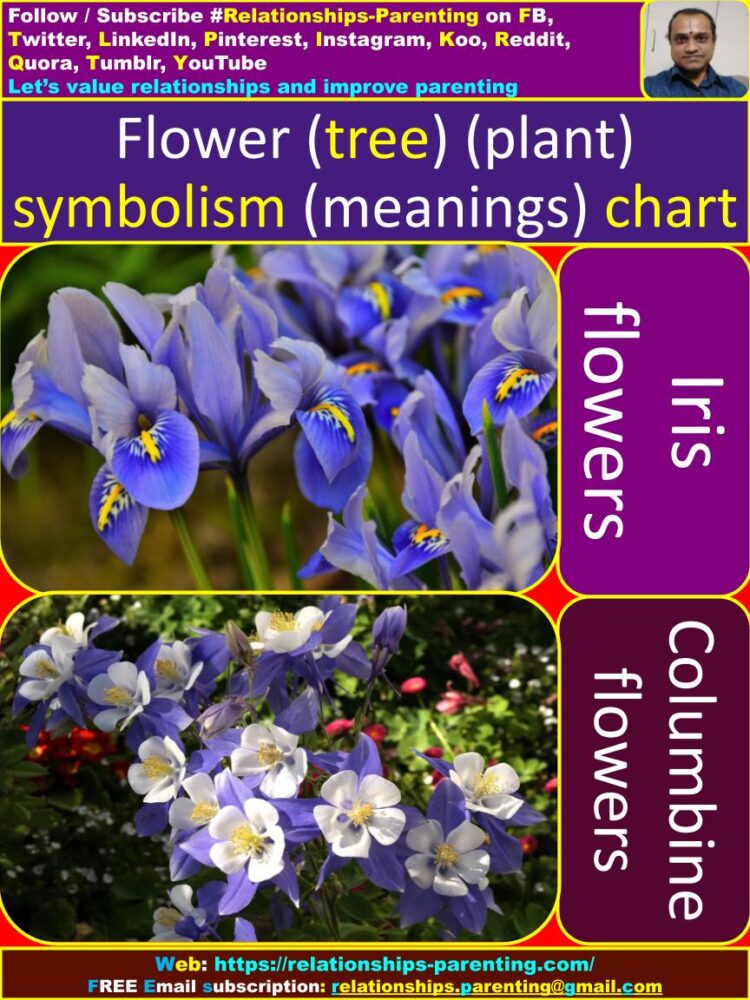
Columbine (purple) : This flower represents resolution, intention, aim, aspiration, purpose, objective, plan, etc.
Columbine (red) : This flower tells about anxiousness, trembling, worry, concerned, fearful, uneasy, perturbed, etc.
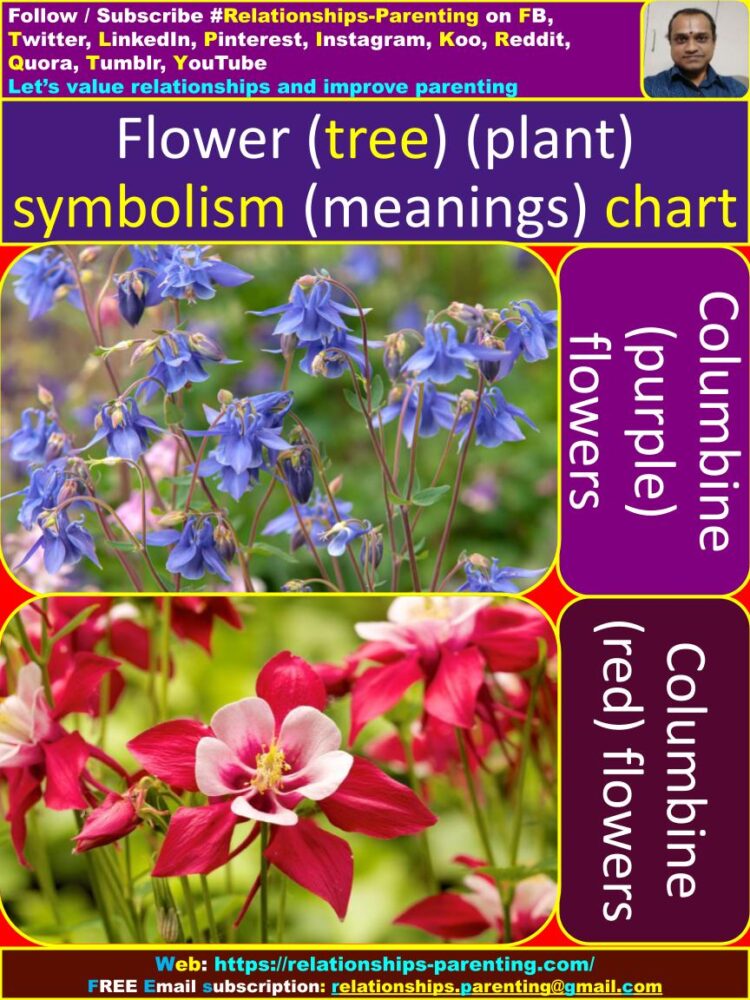
Amaryllis : This flower talks about pride, pleasure, dignity, honor, self-regard, self-identity, etc. These stunning flowers are believed to signify pride, power and determination as they stand tall above all other winter flowers.
Amaryllis is a Greek name meaning ‘sparkle’. In keeping with the festive season when we literally throw glitter on everything.
Bluebell : This flower represents humility, modesty, humbleness, meekness, lack of pride, etc. In the language of flowers, the bluebell is a symbol of humility, constancy, gratitude and eternal love.
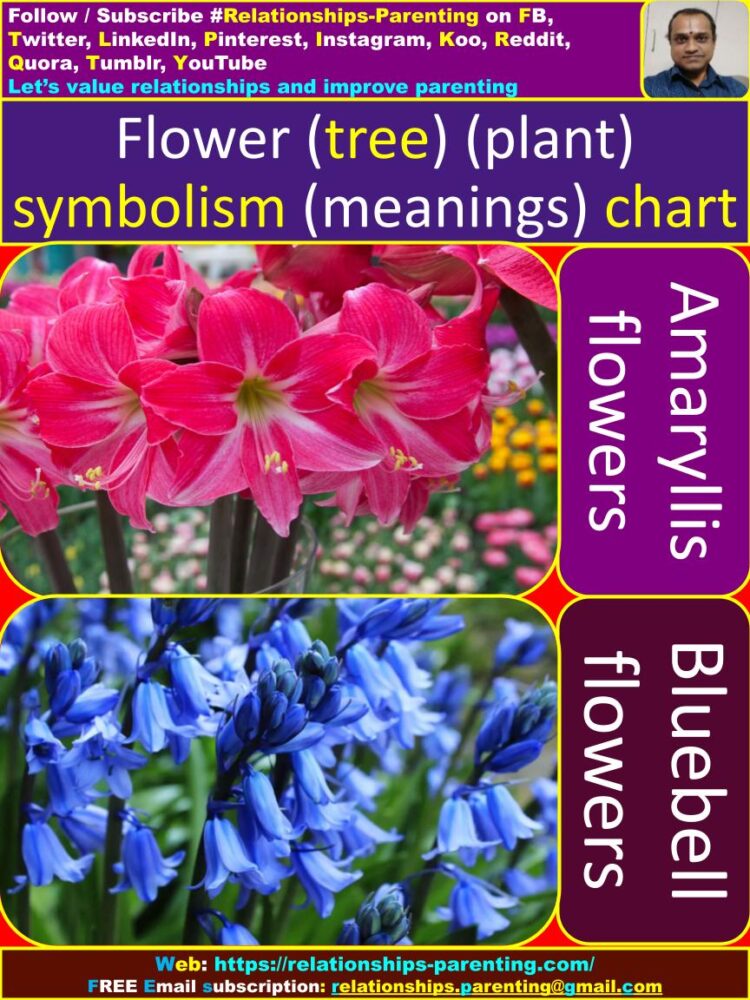
Lady Slipper : This flower talks about capricious beauty, fickle charm, volatile attraction, inconsistent prettiness, etc.
Native American folklore tells the story of a young maiden who ran barefoot through the snow in search of medicine to save her tribe.
But she collapsed on her way back from her mission with swollen, frozen feet. As a result, the beautiful lady’s slipper flowers grew on her feet as a reminder of her bravery.
Salvia (red) : This flower tells about “forever mine”, “you always belong to me”, “everlastingly hers”, etc. A red salvia blooms all summer with the message “Mine forever.” The blue salvia’s message is “I’ll be thinking of you.” Other species of salvia have wider uses and meanings.
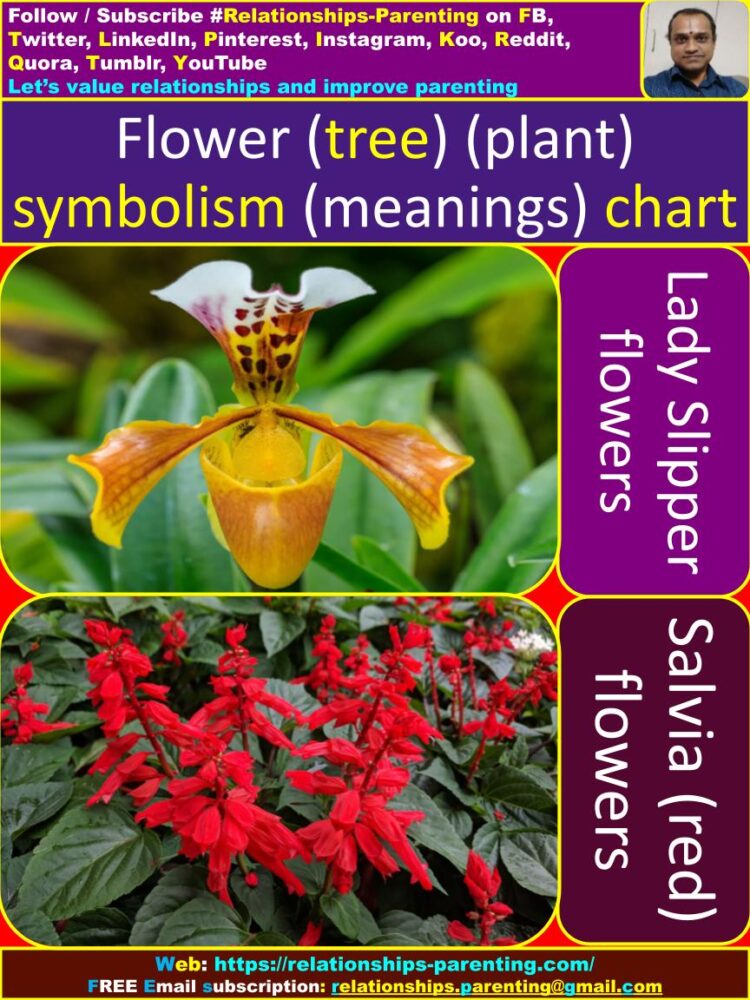
Salvia (blue) : This flower talks about “I think of you”, “I can’t wait to see you again”, “I care about your always”, etc.
The Blue Salvia plant has been linked to healing. This flower species represents wisdom, longevity and good health. It is common for those recovering from illness to receive this herb.
Aster : This flower represents symbol of love, daintiness, delicacy, nicety, gentleness, quiddity, etc. Named after the Greek word for “star” because of the star-like flowers, asters symbolize love, wisdom, faith and color.
Aster flower blooms in pink, red, white, lilac and mauve colors. In Greek mythology, this flower became a symbol of love when it was placed on altars to the gods.

Bittersweet : This flower tells about truth, sincerity, honesty, genuineness, validity, factuality, etc. Bittersweet is used for bridal garlands and other occasions to symbolize loyalty and ward off evil.
Jasmine (white) : This flower represent sweet love, angel, beloved, darling, dearest, favorite, amiability, etc. The meaning of jasmine varies by location and culture, but it usually symbolizes love, beauty, or sensuality.
Its pure white flowers symbolize purity. Because the small, exotic white flowers have such a powerful scent at night, jasmine sometimes symbolizes the value of modesty.
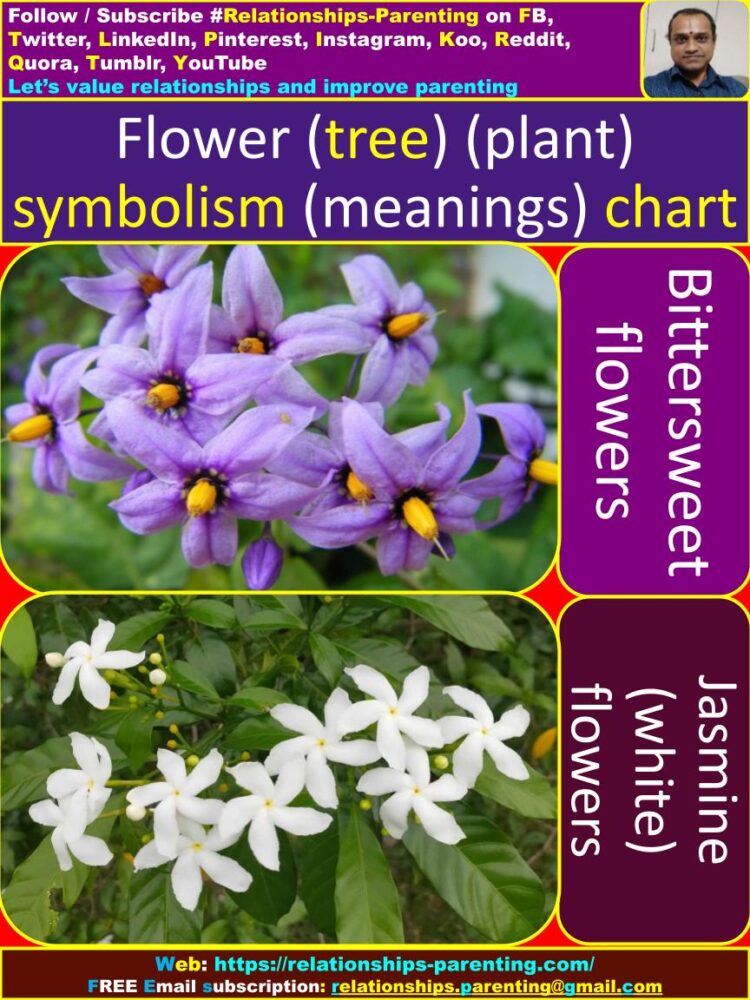
Jasmine (yellow) : This flower talks about grace, elegance, stylishness, finesse, charm, gracefulness, fluency, etc. Yellow jasmine symbolizes love, happiness and friendship.
Tulip (red) : This flower tells about passion, affection, ardor, dedication, devotion, excitement, feeling, fervor, declaration of love, etc.
Flower’s deep red hues evoke feelings of passion, love and lust, making them an especially popular choice for new, younger generation couples. They can also mean “trust me” or “my feelings are true”.
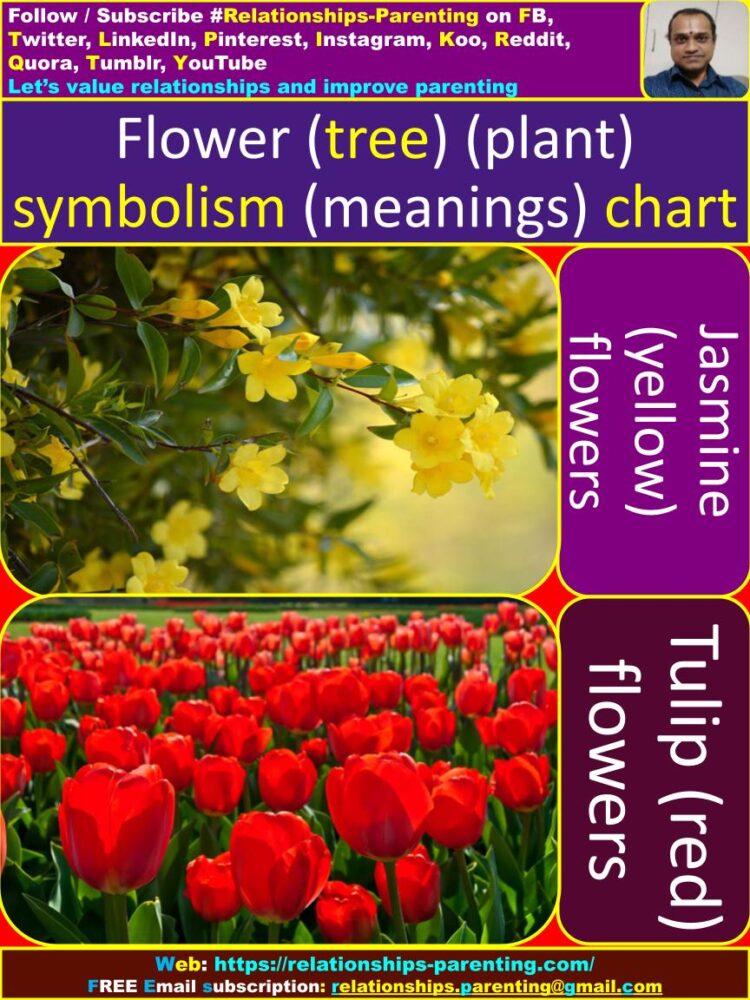
Tulip (yellow) : This flower represents sunshine in your smile, sunrise in your life, aurora, etc. Yellow tulips symbolizes joyfulness, cheerfulness and hope. The Victorians believed that yellow tulips literally meant “sunlight in your smile.”
This is why yellow tulips are so popular as “just” gifts, as they are sure to bring a smile to anyone’s face.
Sweet pea : This flower talks about blissful pleasures, good-bye, thank you for a lovely time, heavenly, etc. The meaning of the sweet pea flower is blissful pleasure. Other meanings of the sweet pea flower include friendship, gratitude and farewell.
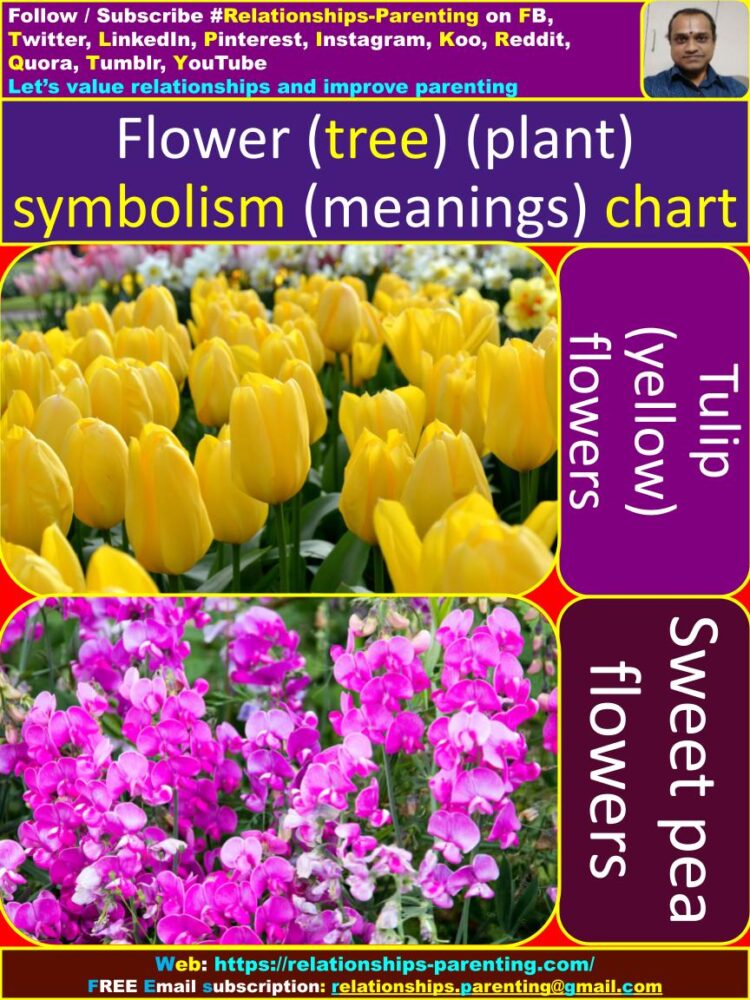
Sweet William : This flower tells about gallantry, bravery, courage, valor, daring, boldness, fearlessness, dauntlessness, manliness, heroism, etc. According to the Victorian language of flowers, Sweet Williams represent valor.
It’s no wonder the Duchess of Cambridge chose to include a white Sweet William in her wedding bouquet in 2011 in honor of her own gallant prince.
Sweet woodruff : This flower talks about humility, modesty, meekness, humbleness, quietness, down-to-earthness, etc.
Perhaps it’s no surprise that this plant has held symbolic, medicinal and folkloric significance throughout Europe for centuries. Woodruff has a Christian symbolic role as Mary’s bedstraw, a fragrant solace to sleep.

Bachelor button : This flower represents single blessedness, felicity, happiness, welfare, etc. Flowers earned their bachelor moniker from the Victorian era. Single men often wear a cornflower in the buttonhole of their suit when courting women.
The flower was a symbol of love and availability, and this practice eventually led to flowers becoming a popular wedding boutonniere.
Clematis : This flower talks about mental beauty, intellectual beauty, psychotic beauty, spiritual beauty, subjective beauty, intellectual goddess, mental advantage, psychic goddess, psychological advantage, etc.
Clematis flowers symbolize the beauty of ingenuity or artistry. Many experts have suggested that this is mostly related to the amazing and intelligent ability to climb around places like walls and trellises.
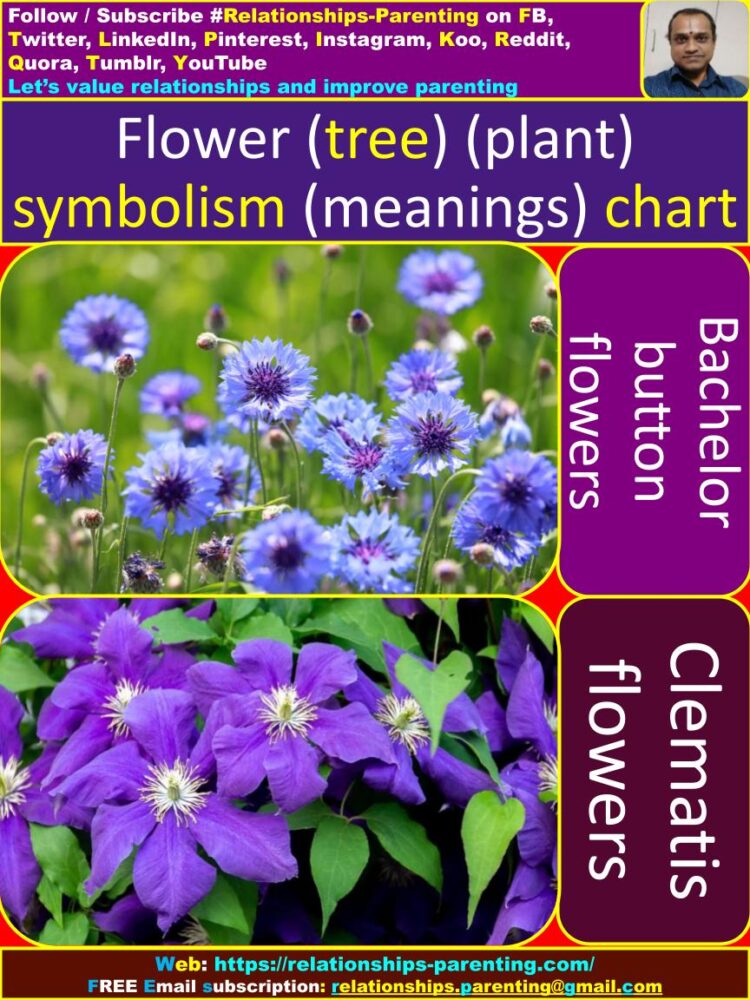
Clematis (evergreen) : This flower tells about poverty, penury, destitution, indigence, pennilessness, deprivation, impoverishment, neediness, want, hardship, etc. Clematis flower symbolizes intelligence, mental acuity, safe travel and social ambition.
Clematis is historically associated with the devil, sometimes called the “devil’s darning needle.” It clings to fences and buildings as a climbing plant, reaching heights and consuming other plants.
Angelica : This flower talks about inspiration, creativity, inventiveness, innovation, ingenuity, imaginativeness, originality, individuality, creative power, creative talent, genius, insight, vision, etc. In the flowers language, Angelica is associated with inspiration.
Giving angelica flowers as a gift means you hope to inspire and encourage someone. Angelica plays a role in many cultures. In European folklore, it is associated with angels and offers protection against witchcraft.
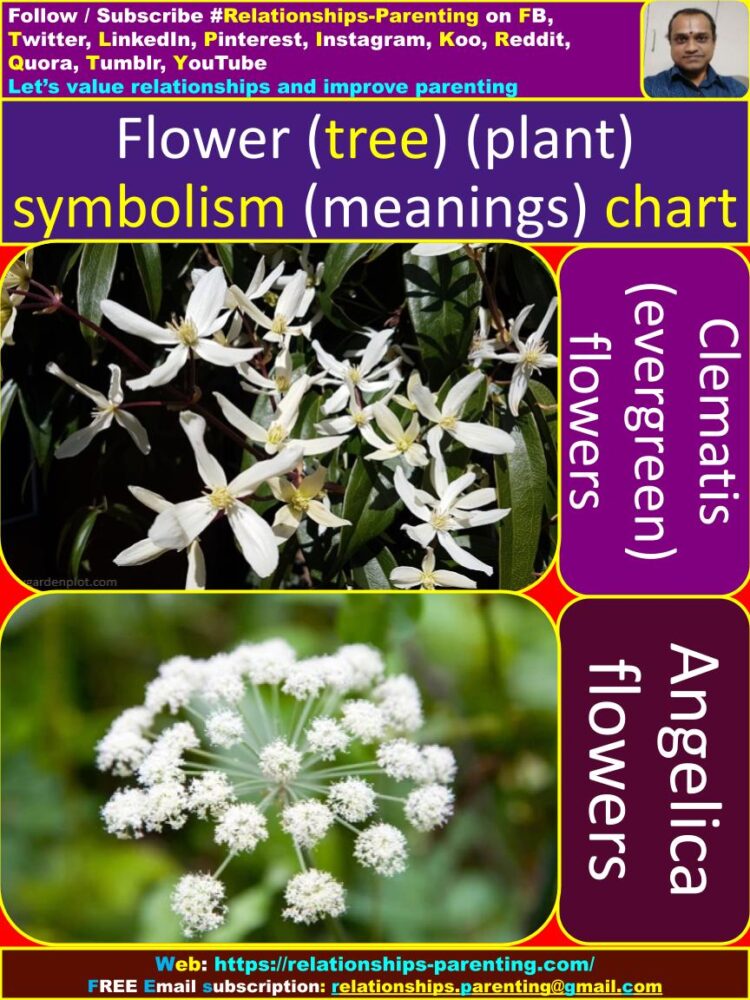
Snapdragon : This flower represents deception, betrayal, deceit, disinformation, duplicity, falsehood, fraud, hypocrisy, and also about graciousness. According to legend, concealing a snapdragon makes a person appear charming and affable.
On the other hand, in the language of flowers, snapdragons are said to represent both deception (perhaps related to the idea of concealment) and grace.
Chrysanthemum (red) : This flower talks about “I love you”, “love from heart”, “love unconditionally”, “love forever”, etc.
Like almost most of the red flowers, red chrysanthemums symbolize love and passion. If you’re looking for flowers for an anniversary or Valentine’s Day, take a break from roses and opt for red chrysanthemum flowers.
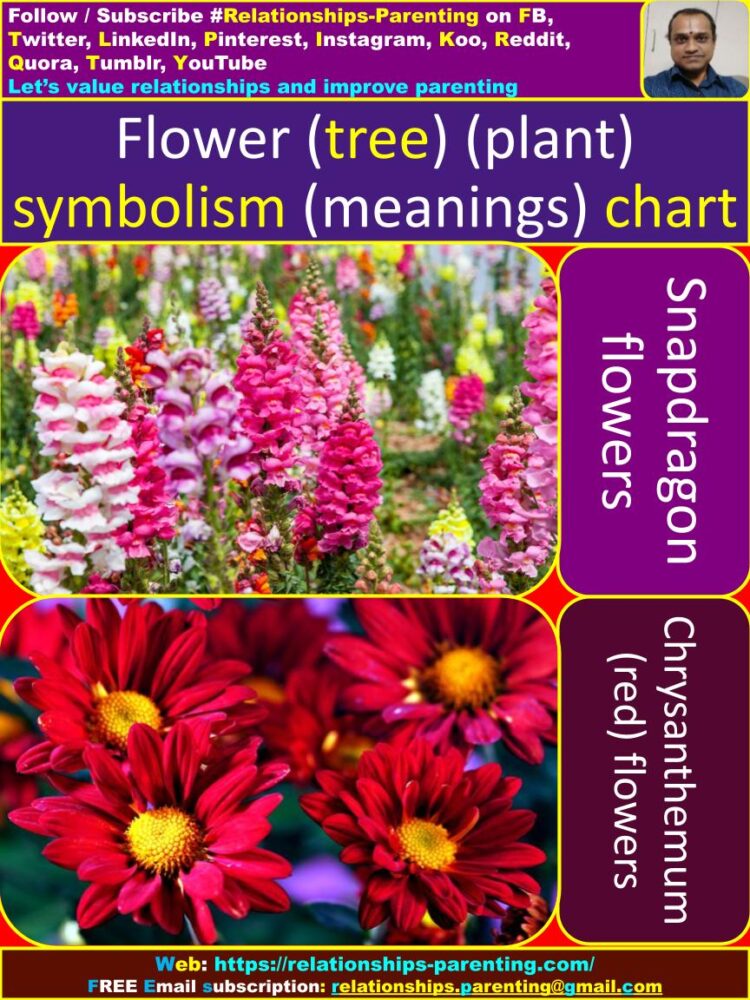
Chrysanthemum (yellow) : This flower represents slighted love, little bit of love, relatively lesser love, etc. Yellow chrysanthemums often symbolize happiness, joy and enjoyment. If you’re looking for a mother to brighten someone’s day, you can’t go wrong with yellow flowers.
Chrysanthemum (white) : This flower talks about truth, veracity, verity, sincerity, candour, honesty, genuineness, accuracy, correctness, rightness, etc. A chrysanthemum white symbolism differs depending on where you are.
In some places, such as Western Europe and Japan, white chrysanthemum flowers are reserved for mourning and mourning. However, in other countries, white flowers are associated with innocence, purity, honesty and loyalty.
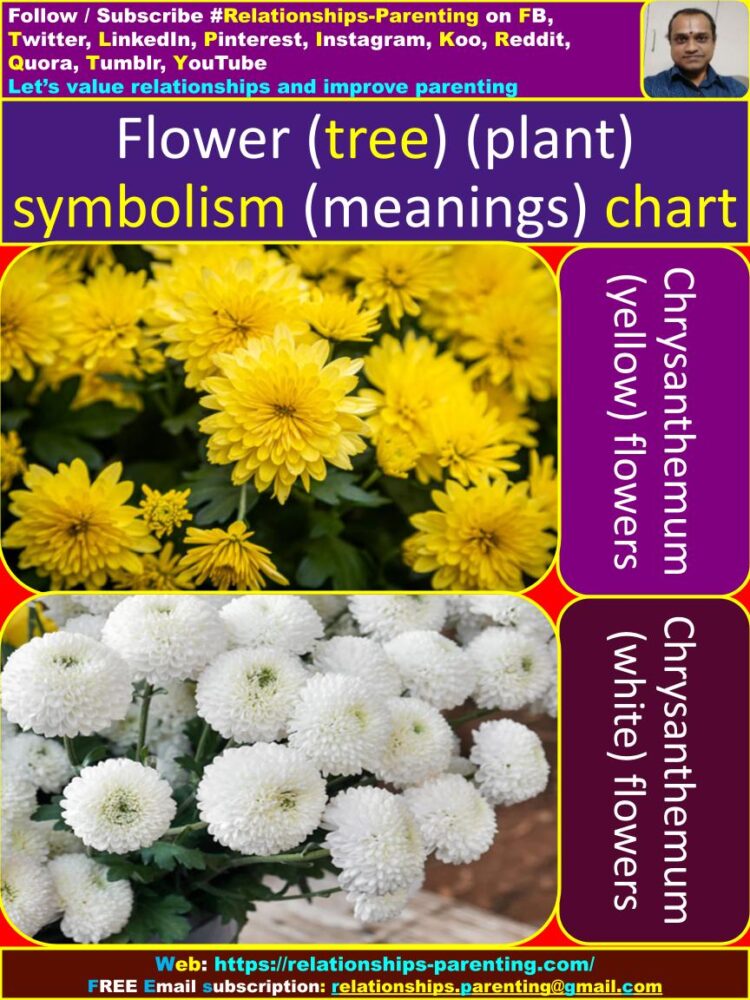
Sage : This flower tells about wisdom, sagacity, sageness, intelligence, understanding, insight, and also about immortality. Sage is usually referred to as an herb of immortality, domestic virtue, health and wisdom.
Sage was a sacred ceremonial herb of the Romans. It has been cultivated for culinary and medicinal purposes in Europe for centuries.
Clover (white) : This flower talks about “think of me”, “imagine me”, “look out me”, “how do you like me”, etc. The Celts of Wales regarded white clover as a good luck charm, capable of warding off evil spirits.
Saint Patrick considered this plant a symbol of Ireland: he used three leaves of common clover to describe the Holy Trinity, the fourth leaf being luck. The word shamrock comes from the Irish word for clover.
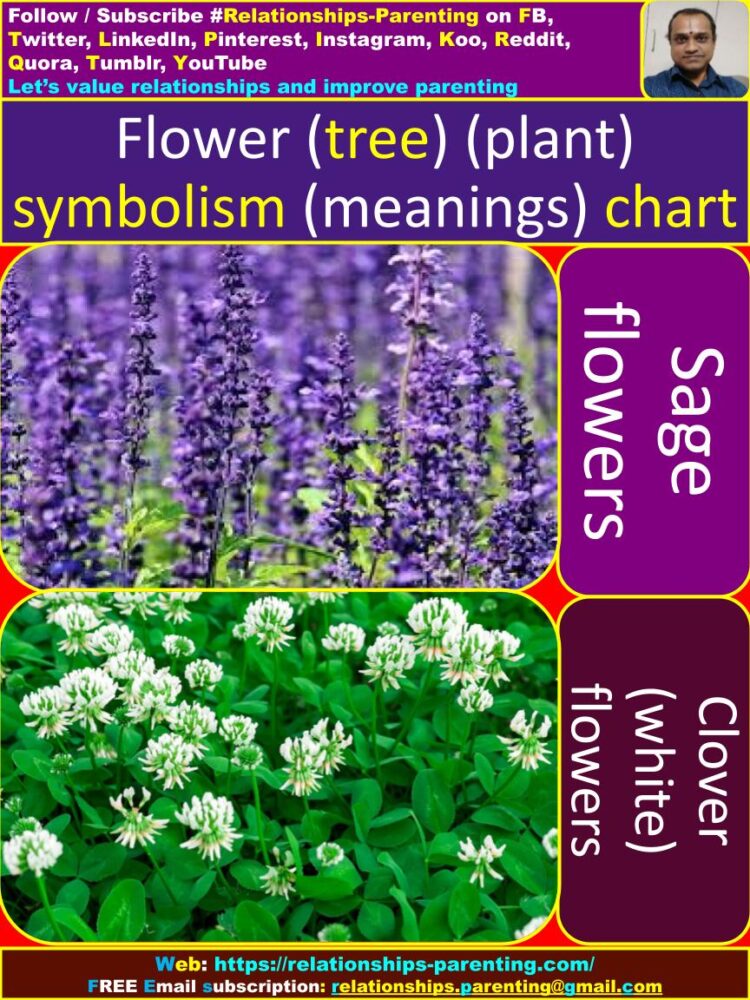
Holly : This flower represents defense, protection, shielding, safeguarding, security, support, and also about domestic happiness. The Druids considered the holly a symbol of fertility and eternal life, thought to have magical powers.
Today, Christians have adopted the holly tree as a symbol of Christmas. The sharp leaves are said to symbolize the crown of thorns worn by Christ, while the fruit represents his blood.
Crabapple (blossom) : This flower talks about fecundity, prolificacy, richness, lushness, marriage, etc. The crabapple flower is often related with fertility, marriage and love.
In general, crabapple flowers are a symbol of youth, wonder and joy. They come in a variety of colors including white, pink and red.
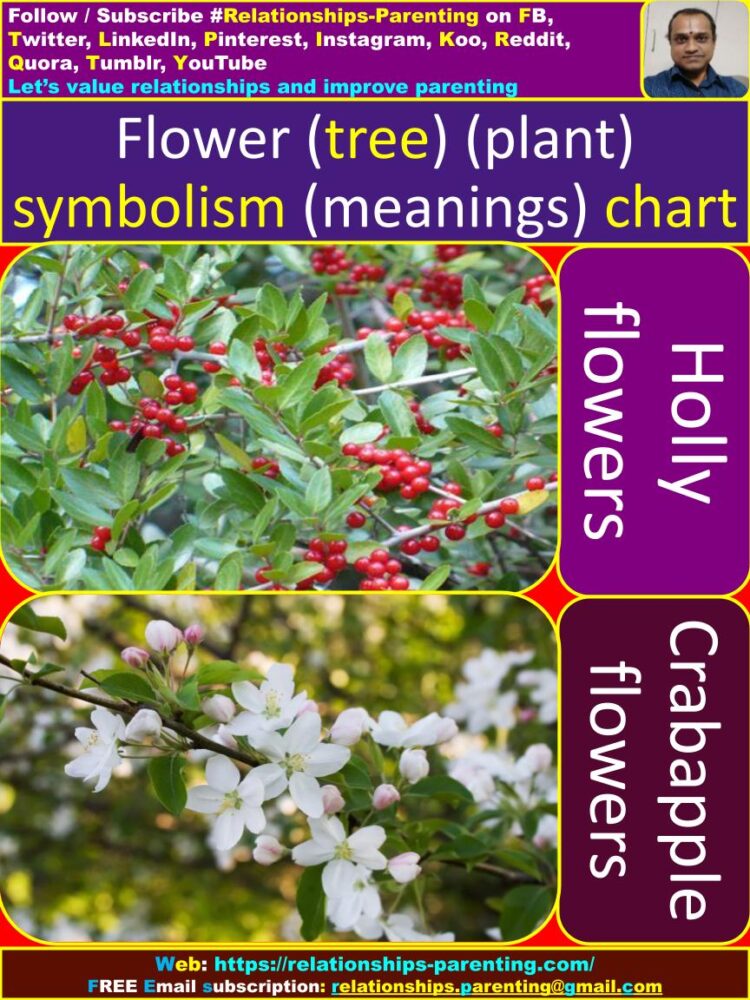
Violet : This flower represents watchfulness, alertness, awareness, humility, modesty, faithfulness, quietness, etc. Violet is thought to symbolize modesty, loyalty, eternal love, innocence, memory.
Daisy : This flower talks about innocence, loyal love, I’ll never tell, artlessness, candidness, credulousness, forthrightness, frankness, freshness, gullibility, ignorance, etc.
The meaning of the daisy flower can be purity, innocence, new beginnings, happiness and joy. In the Victorian era, daisies symbolized loyalty, innocence and the ability to keep things secret.
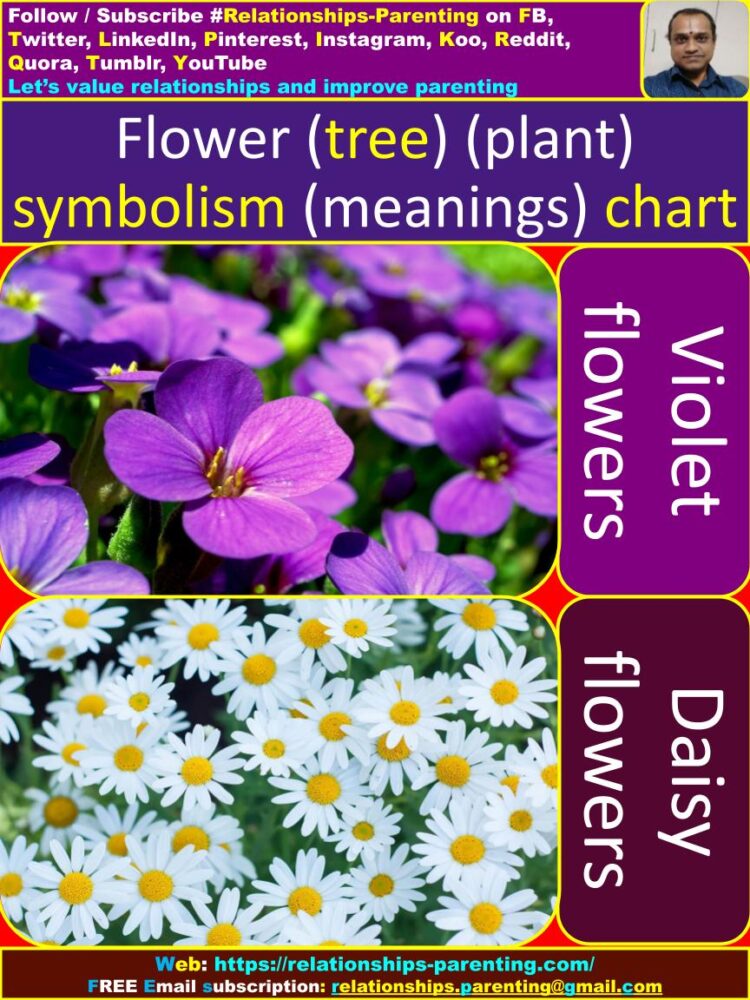
Rosemary : This flower represents remembrance, memory, recollection, memorial, reminiscence, recall, reminder, anamnesis, token, etc. As a sign of friendship, fidelity and remembrance, rosemary is traditionally carried by mourners at funerals.
Rosemary was often rolled into a wreath, dipped in scented water, and worn by the bride on her wedding day as a symbol of love and fidelity.
Camellia (pink) : This flower talks about “longing for you”, craving, eager, languishing, pining, yearning, anxious, ardent, avid, etc. Pink camellias symbolize longing (desiring) for someone and are given to someone missed.
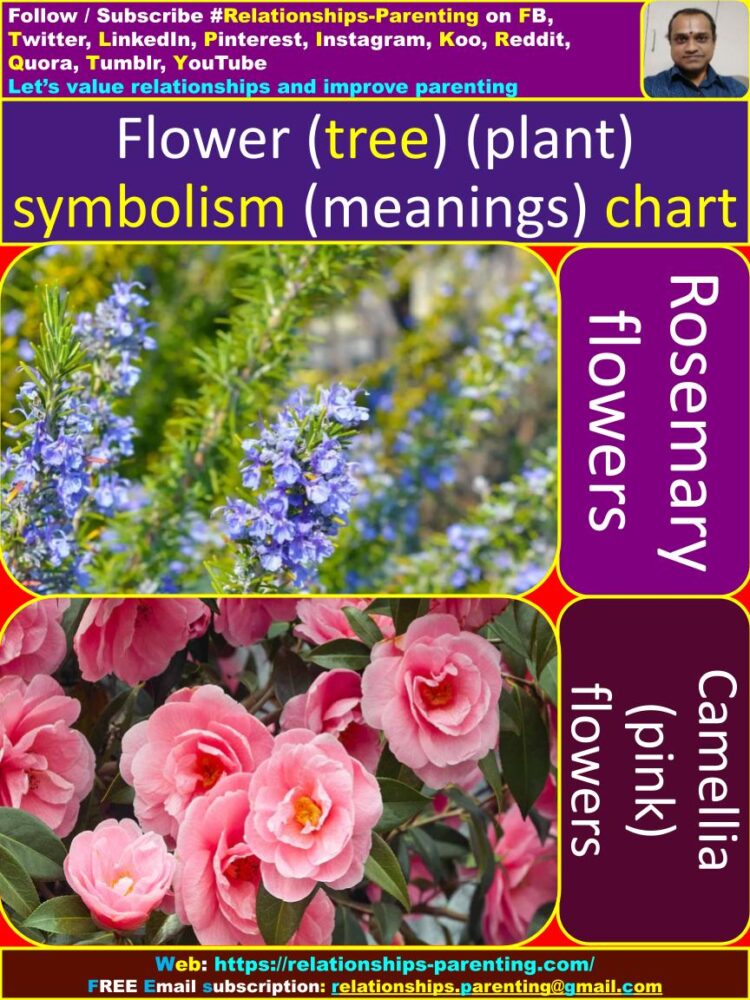
Camellia (red) : This flower tells about “you’re a flame in my heart”, “close to my heart”, “very dearer to my heart”, etc. Dark red camellias symbolize dedication, love, romance and desire. If you want to let someone know you’re attracted to them, give them a red camellia.
Camellia (white) : This flower shows that “you’re adorable”, innocent, charming, captivating, delightful, appealing, attractive, etc.
White camellias symbolize purity and innocence. Hence, they are mostly used in weddings. In Japan, white camellias are often associated with death, so they are a popular funeral flower. However, white camellias can symbolize admiration and respect.
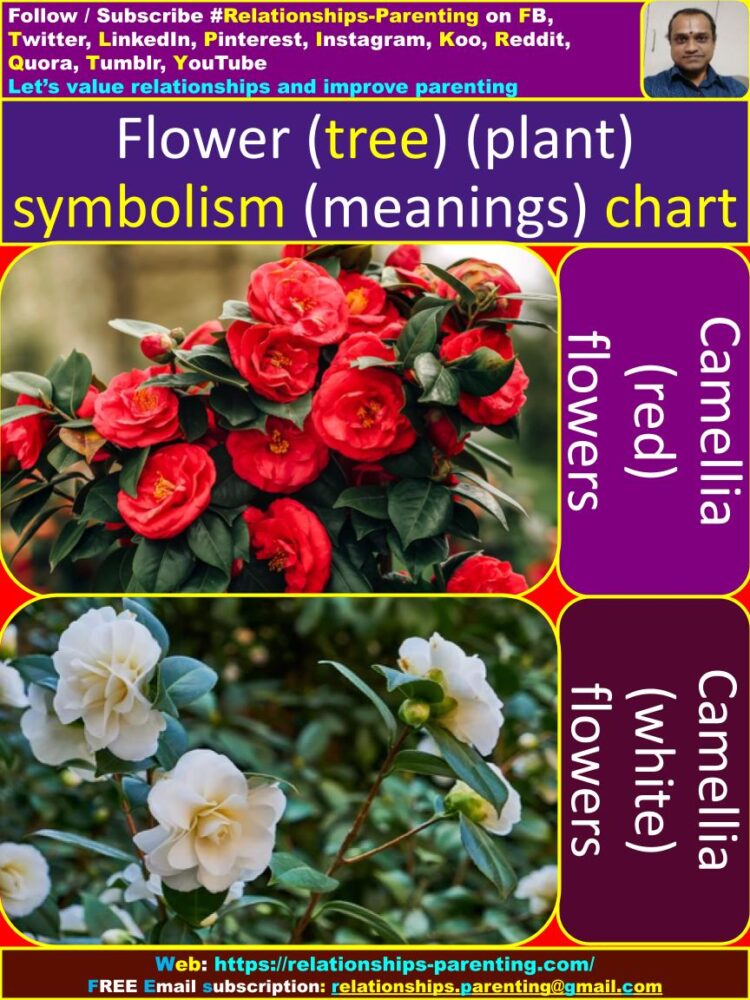
Savory : This flower represents love spice, flavoring, seasoning, relishing, interest, attentiveness, regard, romance, noticing, etc.
In prehistoric Rome, the savory herb had a symbolic meaning of love and romance and was considered a natural aphrodisiac. Summer salt in particular is often used as a powerful remedy to arouse sexual desire.
Anemone : This flower tells about forsaken, abandon, desert, leave, quit, leave behind, turn one’s back on, cast aside, give up, reject, etc. The name Anemone comes from the Greek word for “wind flower”.
According to Greek mythology, the Anemone was born from Aphrodite’s tears as she mourned the death of Adonis. Thought to bring good luck and protect against evil, legend has it that when an anemone closes its petals, it is a sign that rain is approaching.
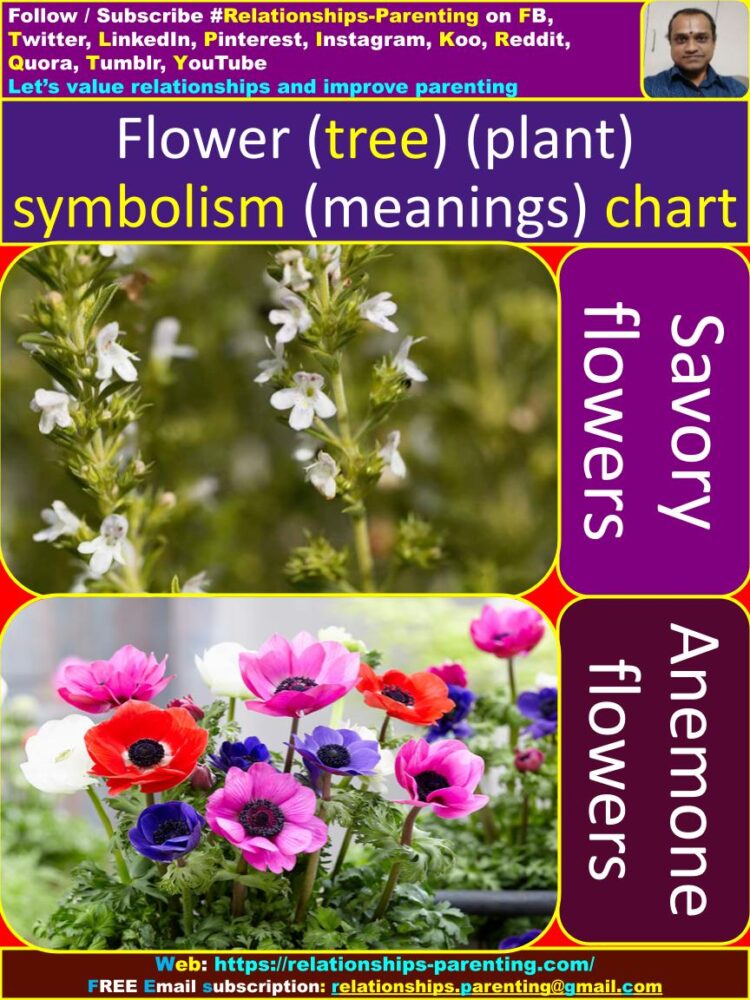
Crocus (spring) : This flower represents cheerfulness, youthful gladness, blitheness, carefreeness, cheerfulness, cheeriness, glee, gleefulness, freshness, youngness, etc.
The crocus is one of the first flowers to pierce through the still cold ground, heralding warmth, light, cheerfulness and merriment. Sometimes called the light bulb flower because of its shape before the petals unfurl, the crocus is also a symbol of youth.
Sunflower (dwarf) : This flower talks about adoration, love, devotion, fondness, warmth, admiration, worship, regard, etc.
This flower symbolizes good luck and happiness (especially in Chinese culture), gratitude (in Victorian floral language, especially with dwarf sunflowers) and adoration and admiration for friends and family.

Sunflower (tall) : This flower represents haughtiness, arrogance, pride, egotism, vanity, conceit and also loyalty, etc. Many groups associate sunflowers with long-term constancy and fidelity, reflecting the tendency of flower buds to follow the sun across the sky.
Greek mythology celebrates the sunflower’s apparent dedication to the sun in the story of a water nymph who falls in love with the sun god Apollo.
Valerian : This flower talks about readiness, preparedness, availability, accessible, on full alert, etc. The Greeks used valerian to ward off evil, hanging bunches of valerian in windows. The Celts hung it in their homes to ward off lightning.
A belief related to its power is that if you throw it into a fight, those involved will immediately stop. The herb is included in both love and sleeping potions.
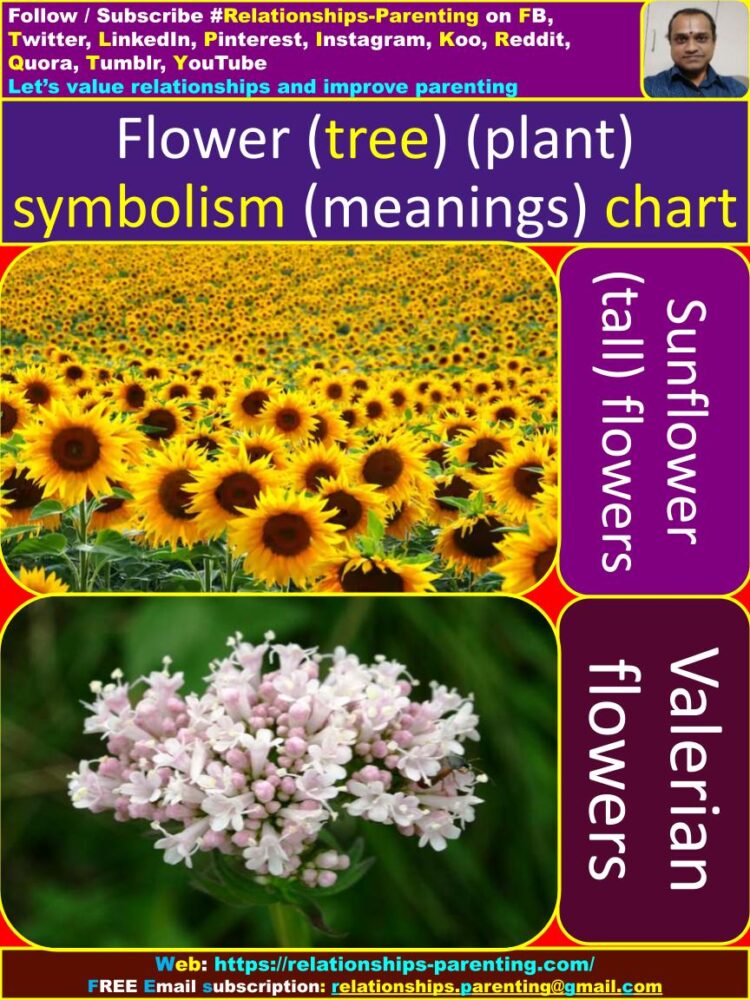
Black-eyed Susan : This flower tells about justice, fair-play, equity, neutrality, righteousness, ethics, integrity, etc. A black-eyed Susan symbolizes encouragement.
Considering its history of adaptation as it traveled from west to east, it is certainly a plant that, determined to survive, flourishes where it is planted. And if there’s one thing gardeners need, especially in mid-August, it’s encouragement.
Rhododendron : This flower talks about danger, risk, insecurity, riskiness, uncertainty, beware, be careful, take care, etc. It is seen as a danger sign and a harbinger of adversity to come.
However, different cultures and traditions attach different meanings to the rhododendron flower. Some see it as a symbol of elegance, wealth, passion and prosperity, while others see it as a threat of death.
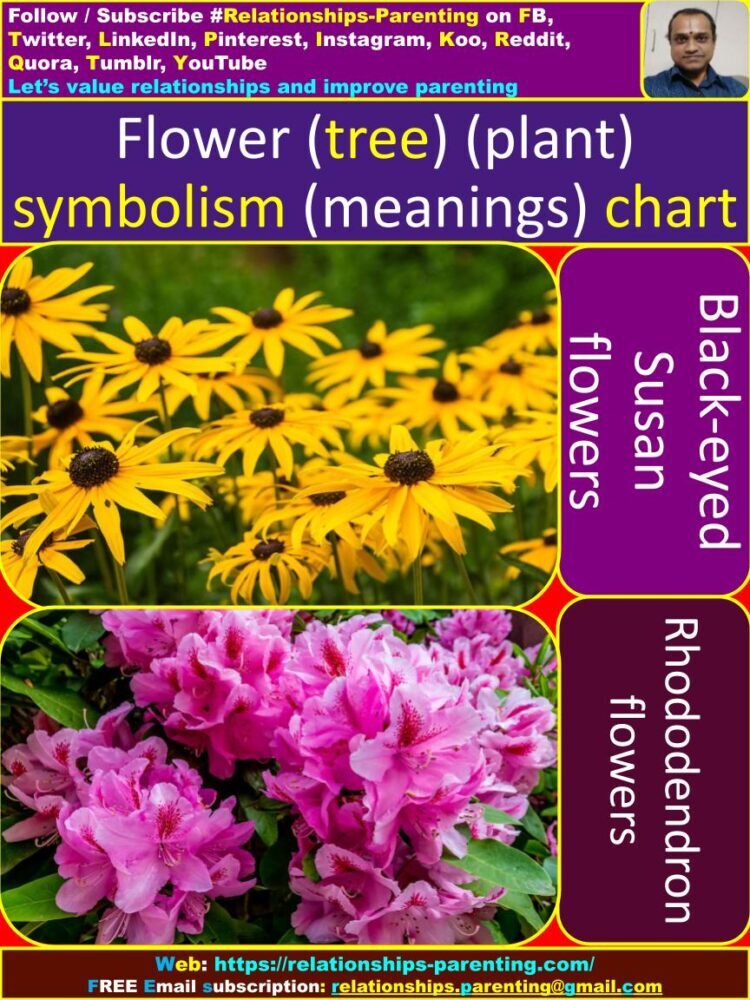
Chives : This flower represents usefulness, practicality, handiness, utility, effectiveness, success, advantages, etc. Chives have long stems similar to leeks and onions. Chive flowers are pale purple, star-shaped spherical balls.
Myrtle : This flower talks about good luck, love in a marriage, good fortune, successfulness, advantage, prosperity, etc.
The myrtle tree originated its name back in ancient Greece, derived from the word ‘myrtos’ meaning ‘shoot’. Both the myrtle tree and its flowers were worshiped by many and thus became a symbol of all things love, luck and prosperity.
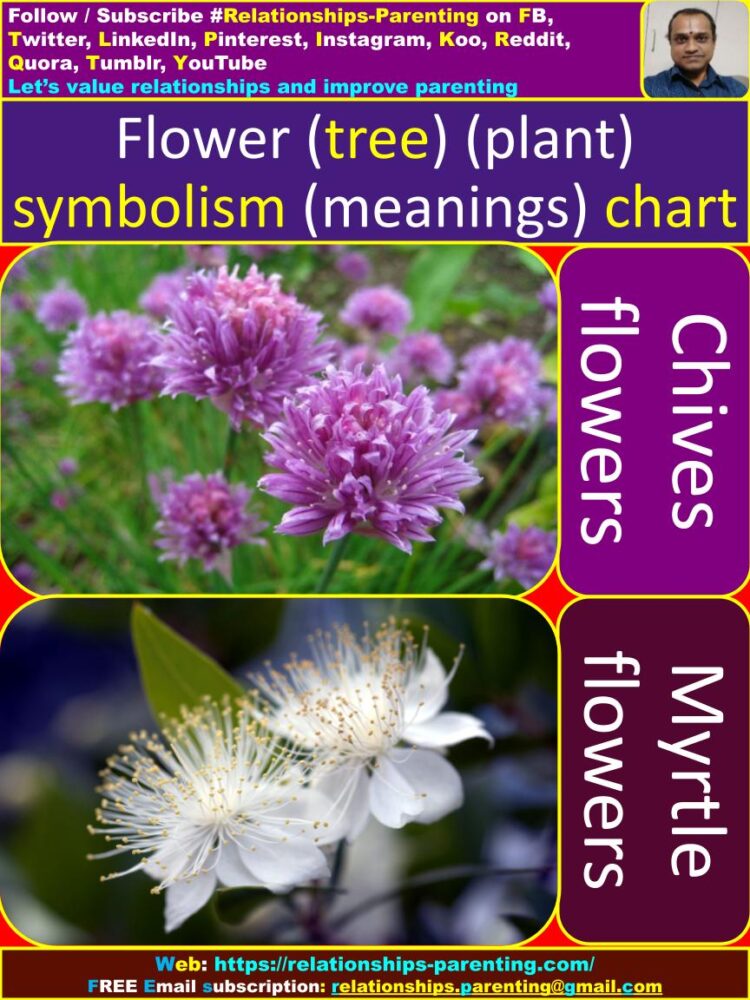
Larkspur : This flower represents open heart, levity, lightness, fickleness, volatility, irregularity, etc. Larkspur symbolizes a strong bond of love.
In general, it signifies an open heart, a passionate attachment to someone, and a celebration of positivity. As with many flowers, the symbolism varies with the color of the flower.
Tansy : This flower tells about hostile thoughts, declaring war, hatefulness, contrary, bitterness, adversity, etc. A seemingly harmless flower, the tansy flower symbolizes a declaration of war.
It is also seen as a symbol of immortality. Tansy flowers are associated with resistance and hatred towards someone. The name Tansy comes from the Greek word for deathless.
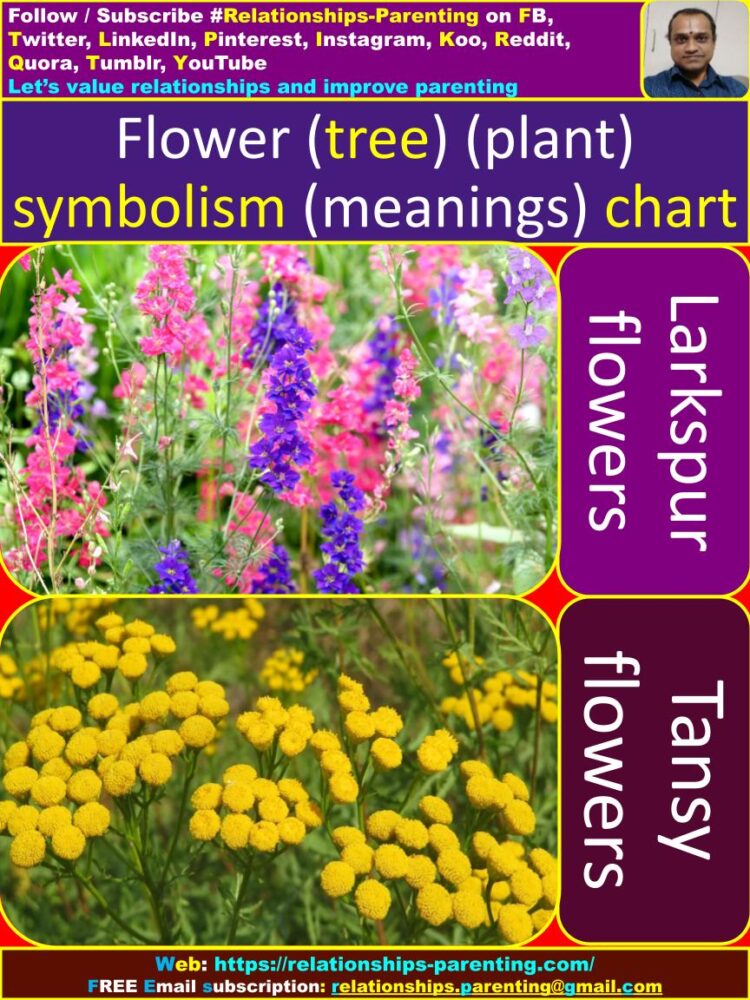
Coriander : This flower talks about hidden worth, merits, price, credit, cost, benefit, quality, rate, etc. Aromatic cilantro (coriander) flowers symbolize lust, and the ancient Greeks used seeds from the plant as an aphrodisiac.
Calla lily : This flower represents beauty, charm, Goddess, enchantment, pleasing, appealing, etc. On the one hand, the meaning of the calla lily expresses the idea of life and fertility, on the other hand, it is a well-known symbol of death.
An early calla lily meaning originated in ancient Greek culture, where the flower was thought to represent majestic beauty. This origin comes from the story of Hercules as a child.
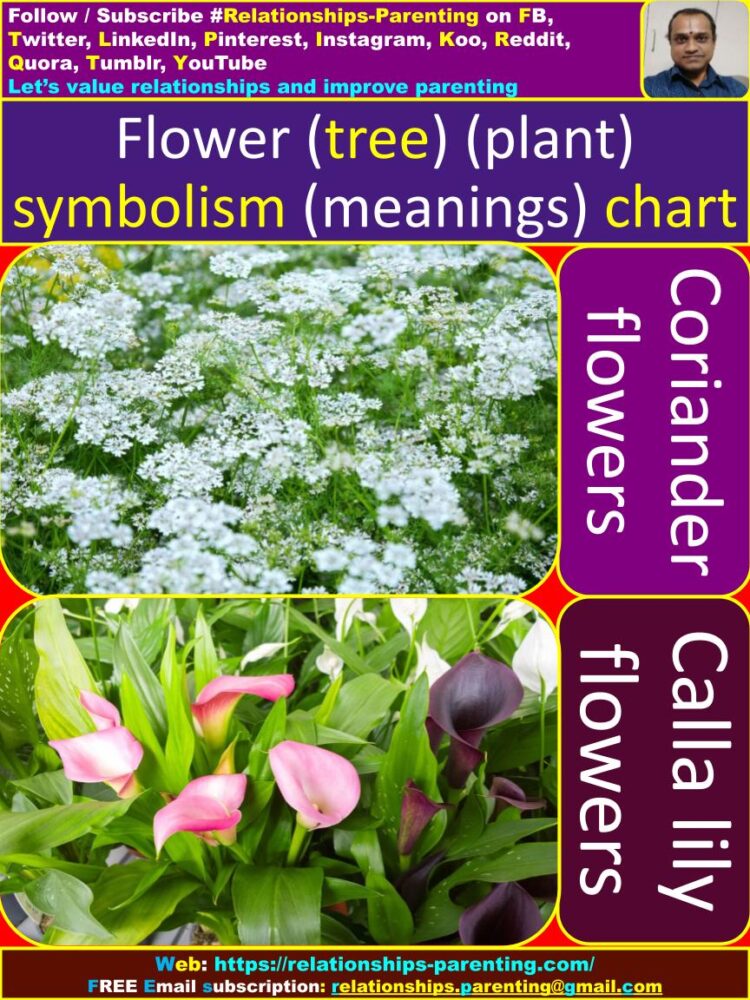
Hibiscus : This flower tells that it is a delicate beauty, exquisite, airing, graceful, intricate, etc. Yellow hibiscus is often associated with joy, sunshine and luck!
Red hibiscus is a symbol of love and passion. Pink hibiscus symbolizes friendship and all kinds of love – not just romantic!
Apple blossom : This flower represents preference, inclination, desire, wish, proclivity, penchant, etc. The apple blossom is a symbol of longevity and “represents the concept that life continues even after we endure ‘death’ in the winter of our lives.” We love using these flowers in spring arrangements.
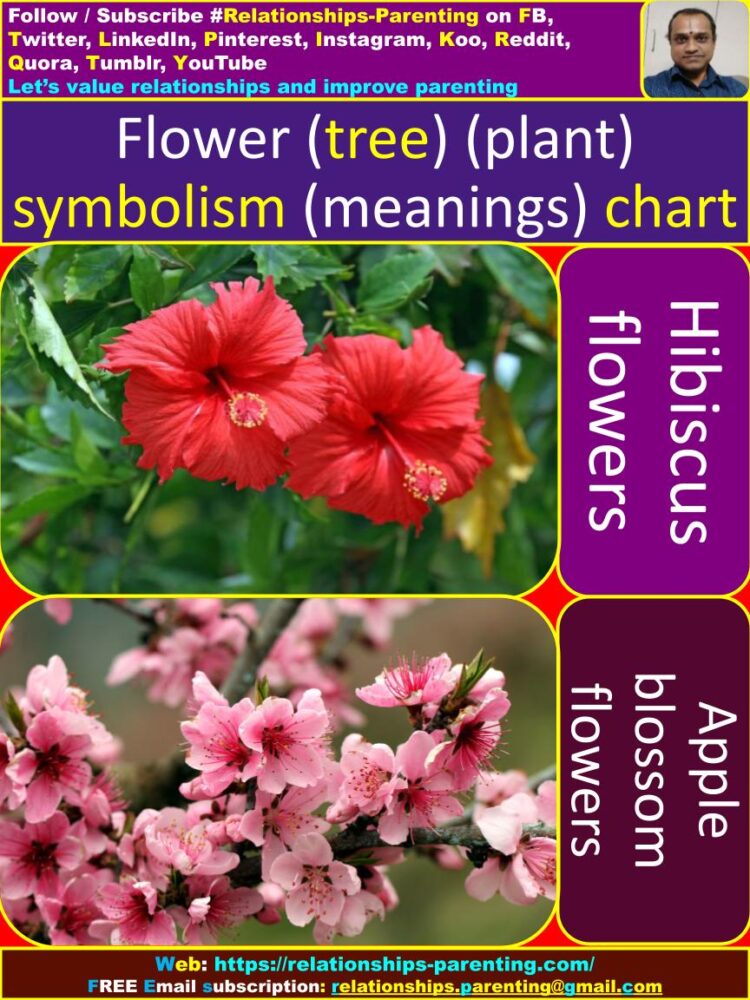
Forget-me-not : This flower talks about “true love memories”, “do not forget me”, “always remember me”, etc. Forget-me-not symbolizes paramour love and respect.
When you give these small flowers to someone, it represents a promise that you will always remember them and keep them in your thoughts. They are considered a symbol of loyalty and loyalty.
Magnolia : This flower represents nobility, Love of nature, virtue, goodness, honesty, decency, generosity, bravery, etc. In the United States, the magnolia tree symbolizes good luck and stability. It is a staple in southern gardens and delights people with its flowers in early spring.
In the East, the white flowers of magnolia represent nobility and purity, but many of its parts are used in traditional folk medicine.

Cyclamen : This flower talks about resignation, diffidence, goodbye, departure, leaving, retirement, quitting, etc.
Cyclamen symbolizes a compassionate, devoted heart and is therefore planted next to old monasteries, ribats (Islamic monasteries, a type of fortress) and churchyards in countries around the Mediterranean. Cyclamen is the sacred flower of love in Japan.
Lavender : This flower tells about distrust, suspicion, wariness, lack of trust, doubtfulness, disbelief, discredit, etc. Lavender flowers represent freshness, quietness, devotion, serenity, grace and calmness.
Purple is the color of royalty and also speaks of elegance, refinement and luxury. The color is also associated with the crown chakra, an energy center associated with higher purpose and spiritual connection.
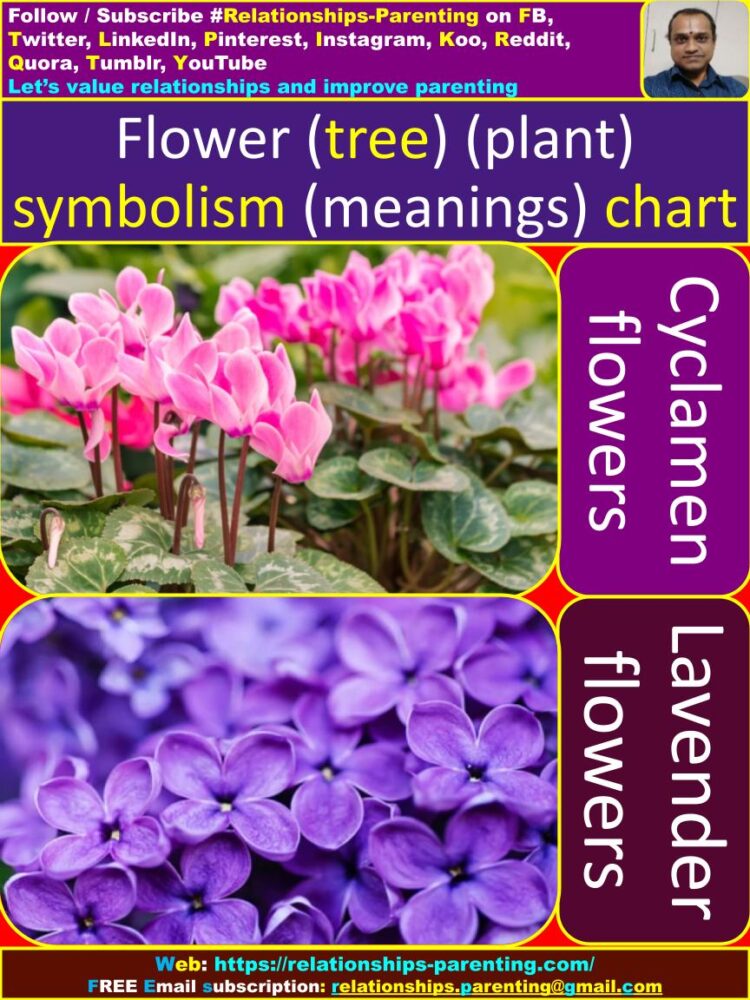
Thyme : This flower represents, strength, power, gumption, courage, bravery, hardihood, peace, prowess, etc. This herb is a symbol of bravery and activity and was widely used by the ancients to treat hookworm.
In Greek times thyme was a symbol of graceful elegance and human activity: “The smell of thyme was an expression of praise.” The Romans associated thyme with the goddess Venus.
Candytuft : This flower tells about indifference, lack of concern about, disregard, mindlessness, weariness, etc. The plant is origins in southwestern Europe and is often used as a flowering ground cover, symbolizing indifference.

Pansy : This flower talks about thoughts, idea, notion, line of thinking, belief, concept, conviction, opinion, view, impression, etc.
In Shakespeare’s ‘A Midsummer Night’s Dream’, pansy juice is used in love potions, a reference to the use of the flower in herbal remedies and love potions by the ancient Greeks and Celts. In Victorian England, people gave these flowers to each other to express romantic feelings.
Arborvitae : This flower represents unchanging friendship, eternal devotion, forever love, consistent, changeless, etc. Derived from the name “Arborvitae” meaning “tree of life” in Latin.
These trees symbolize strength, longevity and eternal friendship. During New Year celebrations in China, aromatic branches are used as good luck charms.
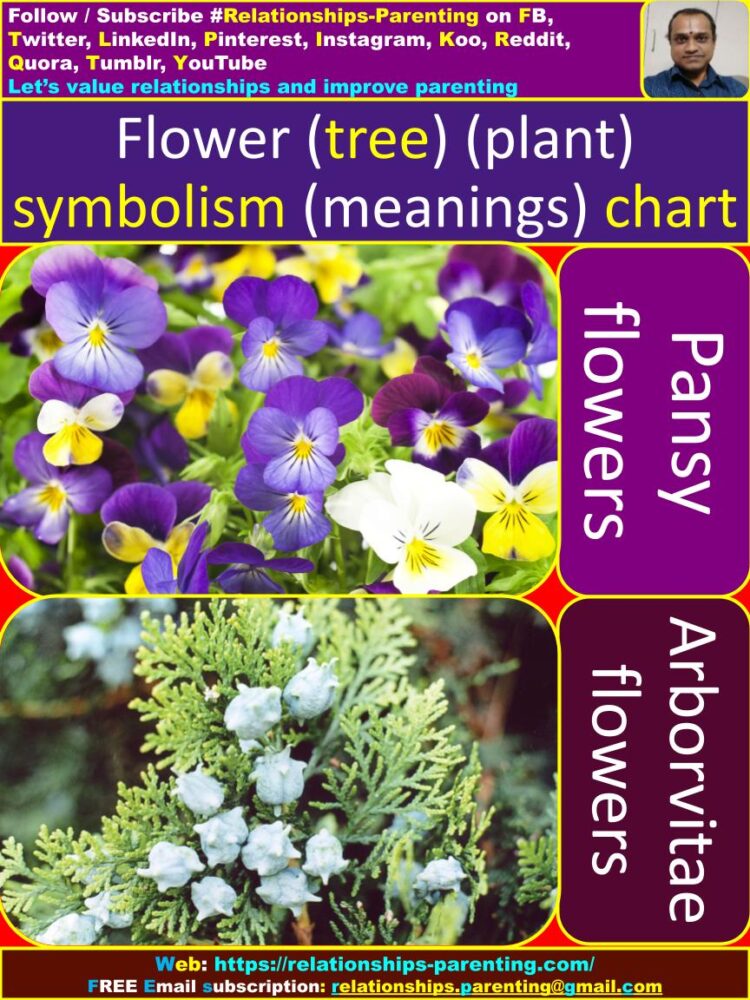
Borage : This flower talks about bluntness, bluff, brusque, crusty, curt, and gruff directness, etc. Borage, sometimes spelled as borage, is thought to come from the Celtic borach, or courage, because the plant was sacred to the Druids:
weapons were consecrated with it before battle, and their warriors prepared for battle by drinking borage-infused wine.
Lotus Flower : This flower tells about purity, Enlightenment, Self-regeneration, and Rebirth. Lotus is a plant belonging to the Nelumbo genus and is associated with purity, rebirth and divinity. This flower has a high regards in Hinduism.
The lotus flower symbolizes rising from a place of darkness to beauty and rebirth, because that is exactly how the lotus flower grows.
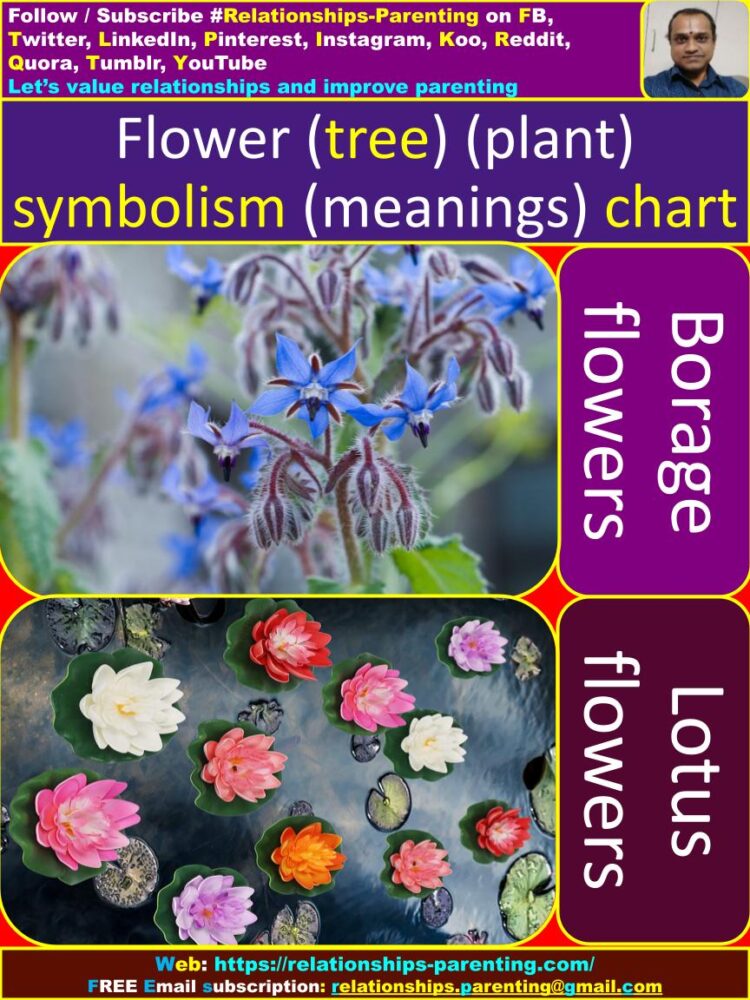
Mint : This flower represents virtue, goodness, morality, ethicalness, uprightness, integrity, honesty, etc. In the flowers language, mint symbolizes virtue. Mint derives its name from Greek mythology;
The god Pluto preferred the nymph Mentha over the goddess Persephone, who (out of jealousy) turned Mentha into a plant.
Peony : This flower tells about bashfulness, coyness, diffident, happy life or shame, etc. A peony is traditionally given as a symbol of love, respect, happiness wealth, romance and beauty in general, and as an expression of goodwill, greetings and happiness on special occasions.
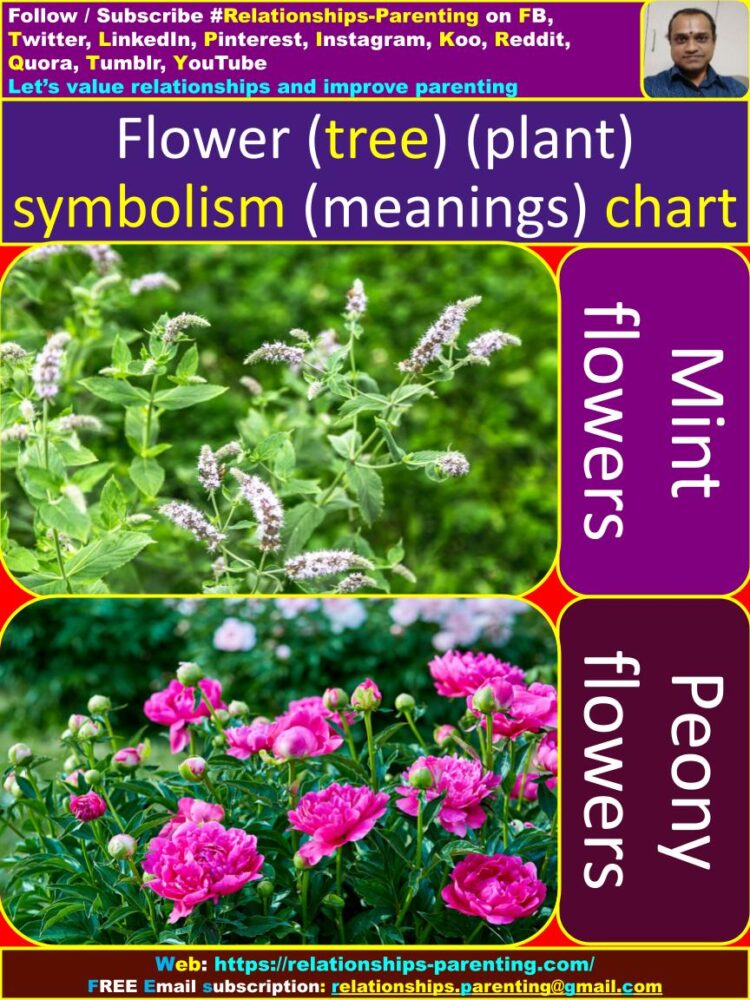
Daylily : This flower represents Chinese emblem for mother, symbol, representation, sign, etc. In China, daylilies are associated with forgetfulness and memory loss, or in some cases, they symbolize “forgetting worries.”
When someone has a bit of a rough patch they are usually gifted so that they can overcome it and move on.
Southernwood : This flower talks about constancy, trueness, dedication, jest, funny remark, witticism, sportingly, etc. Southernwood is a delicate-looking plant with a symbolic history spanning the ages.
It is widely regarded as a symbol of dedication or new love, as well as a powerful form of protection, particularly from insects.
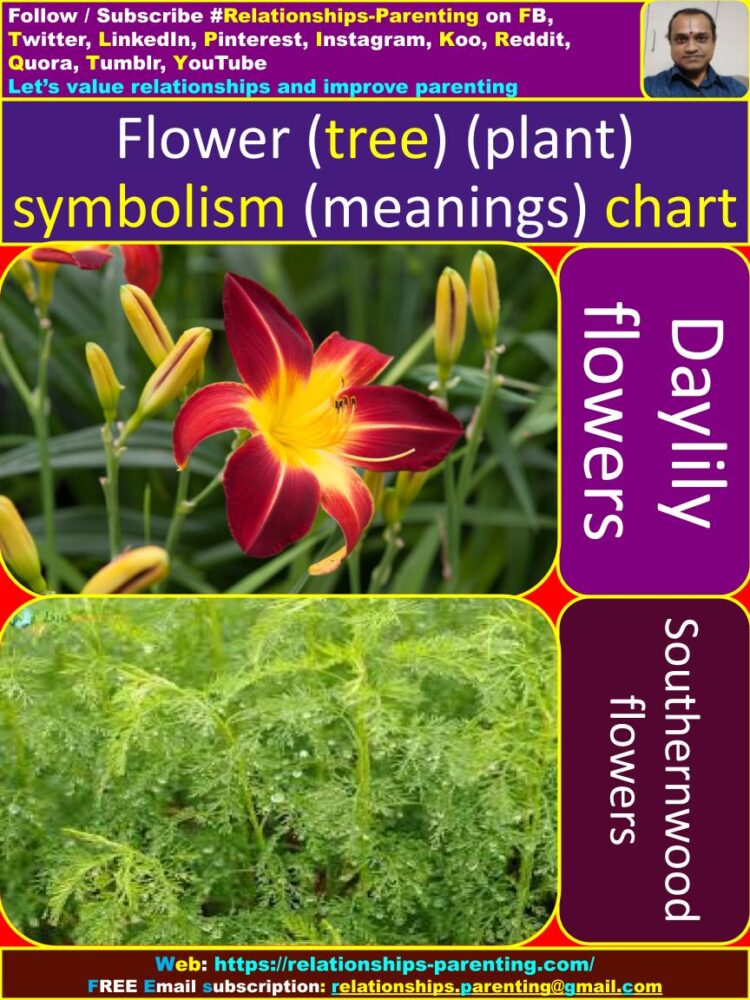
Marjoram : This flower tells about joy, happiness, pleasure, contentment, satisfaction, cheerfulness, merriness, etc. Marjoram is said to represent happiness and well-being to ancient civilizations. Hence it is often found in popular legends.
Marjoram was associated with Aphrodite, the goddess of love and sexuality in Greek mythology, and thus found its way into love stories.
Dill : This flower talks about Powerfulness against evil, wicked, immoral, wrongful, ungodly, sinful, unholy, etc.
Various parts of the world believe in dill’s protective powers. The ancient Romans believed that dill brought good luck – they valued dill as a symbol of vitality, joy and happiness.
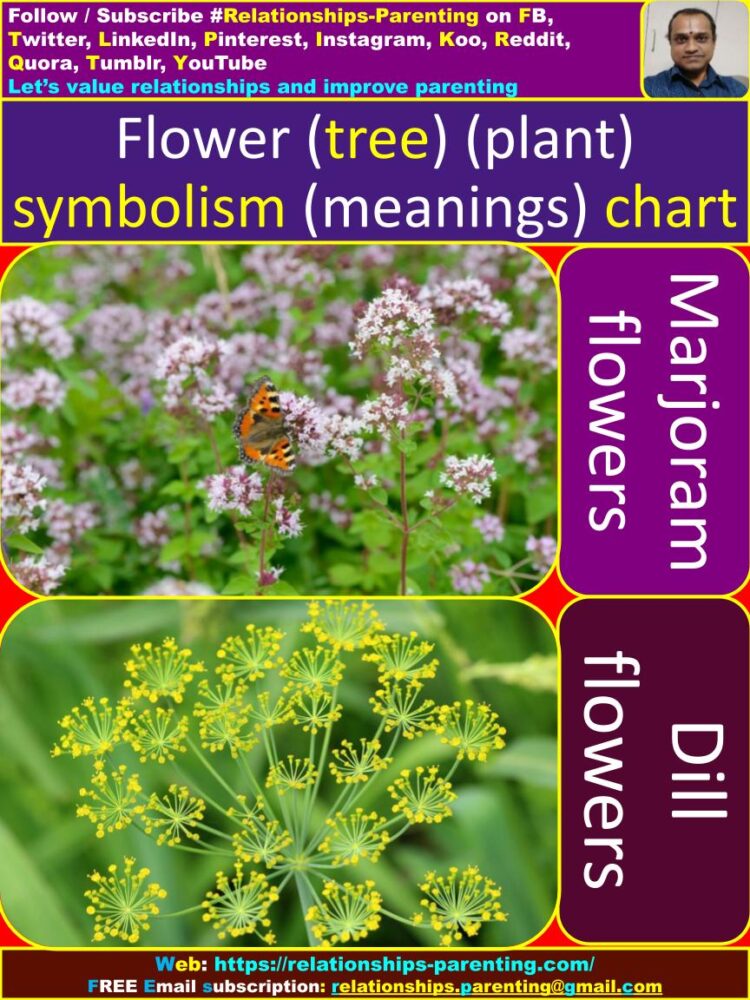
Parsley : This flower represents festivity, jolliness, euphoria, jubilance, high spirits, gleefulness, revelry, etc. Parsley was originally used in rituals and for its medicinal properties. The Greeks highly valued parsley.
For example, heroes and warriors in ancient Greece were honored with garlands of parsley—symbolizing joy and festivity.
Daffodil : This flower talks about regard, appraise, contemplate, assess, unequalled love, etc. The daffodil flower symbolizes rebirth and new emergence.
It is one of the first flowers to bloom in late winter, heralding the start of spring and the end of cold, dark days. Less commonly, daffodils can be symbols of creativity, strength, resilience, forgiveness and vitality.
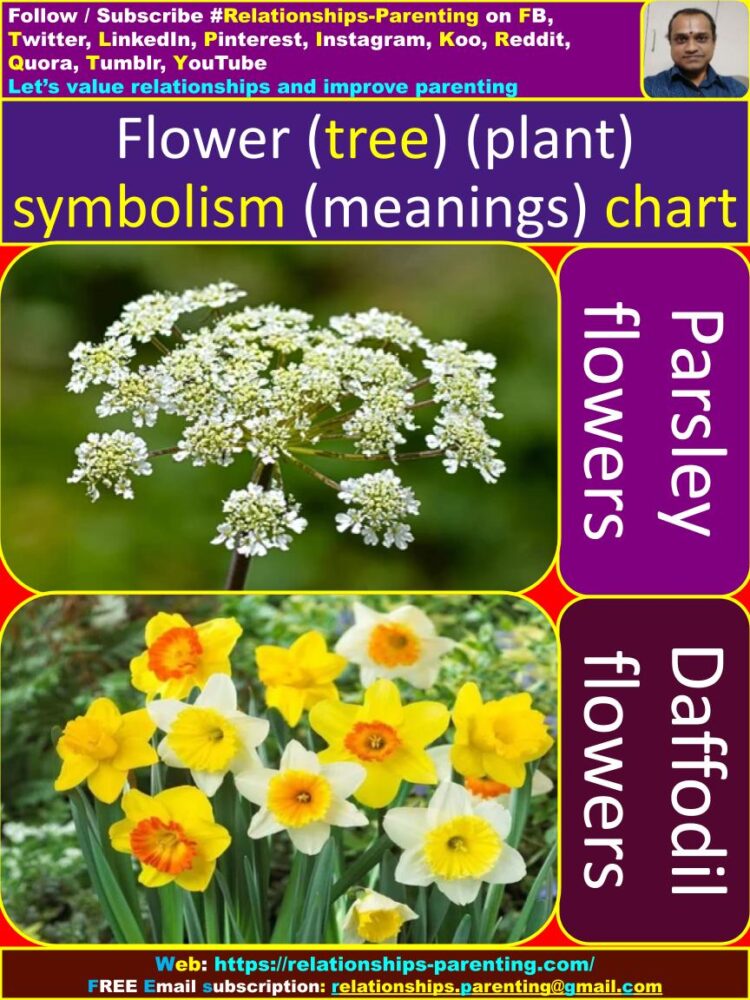
Nasturtium : This flower represents patriotism, nationalism, jingoism conquest, victory in battle, etc. Nasturtium flower indicates victory in battle.
Orange is the color of joy and creativity, promoting a sense of well-being and emotional energy that must be shared through compassion, enthusiasm and warmth.
Heliotrope : This flower talks about eternal love, devotion, forever love, everlasting love, infinite love, etc. Heliotrope represents undying love.
Often seen as a symbol of eternal love, heliotropes remain a symbol of eternal love and passion over time. Heliotropes are recognized as symbols of salvation and devotion in various religions.
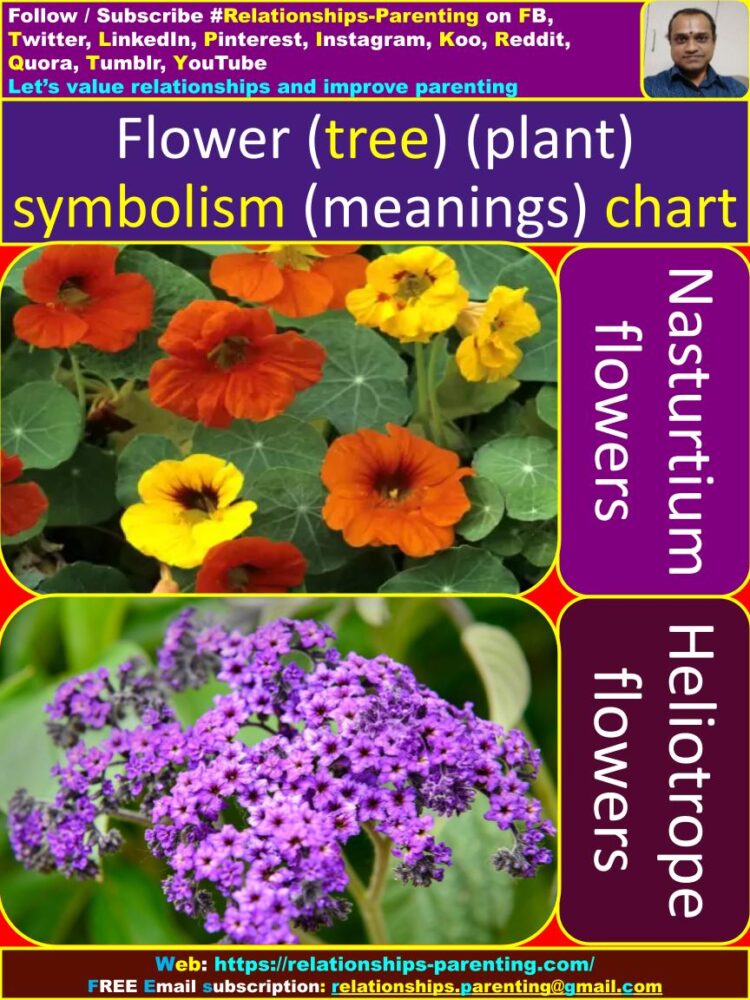
Fern : This flower tells about magic, fascination, enchanted, charming, marvelous, secret bonds of love, etc. The fern symbolizes perpetual youth. For the indigenous Maori of New Zealand, the fern represents new life and new beginnings.
For the Japanese, the fern symbolizes family and hope for future generations. According to the Victorians, the fern symbolized modesty and honesty.
Gladiolus : This flower represents gladiators, integrity, power, strength, victory, success, triumph, achievement, etc.
Generally, gladioli represents strength of character, loyalty, moral integrity and memory. Gladioli is actually the traditional 40th anniversary flower and the birth flower of August.
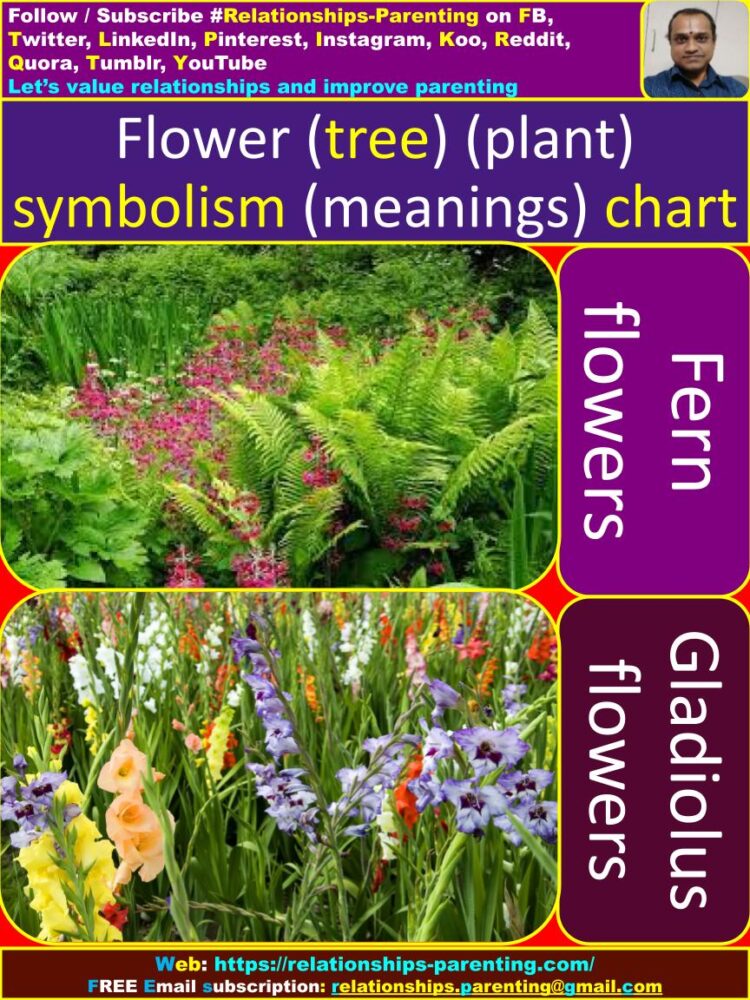
Coreopsis : This flower shows to be always cheerful, merry, joyful, high spirits, elated, gleeful, etc. In the flowers’ language, coreopsis means “always cheerful,” and these delightful natives of America live up to this designation in spectacular fashion.
Equally at home in naturalized meadow settings or manicured landscapes, coreopsis provide a beautiful sunny presence wherever they make their home.
Hollyhock : This flower represents ambition, aspiration, intention, goal, aim, purpose, intent, plan, design, wish, etc. Hollyhocks symbolize the circle of life, intention, fertility and abundance.
They are traditionally planted near the front door of homes to welcome prosperity. Egyptians often placed wreaths of hollyhocks with stuffed animals to aid them on their journey to the afterlife.
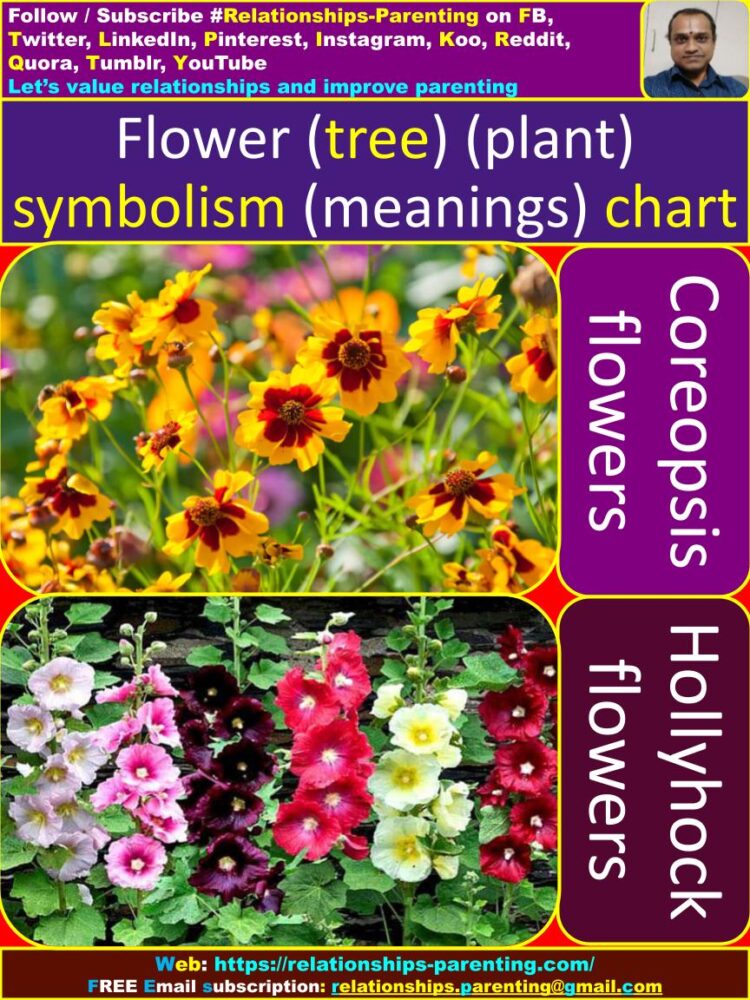
Gardenia : This flower shows that “you’re lovely”, “secret love”, amour, fling, goings-on, hanky-panky, liaison, playing around, etc. Gardenia is a flower that symbolizes freshness and gentleness. However, this sign mostly depends on the color of the gardenia.
For example, a white gardenia fits this meaning well. Another symbol of gardenia is secret love and happiness between two people.
Pine : This flower talks about humility, modesty, meekness, lack of pride, piety, devotion, sanctity, faith, etc. It is often associated with virtue and longevity, with immortality.
The pine tree is traditional for the Japanese New Year, a symbol of rebirth, renewal and a bright (hopeful) future. The sapling above captures the symbolic reference to longevity and rebirth.
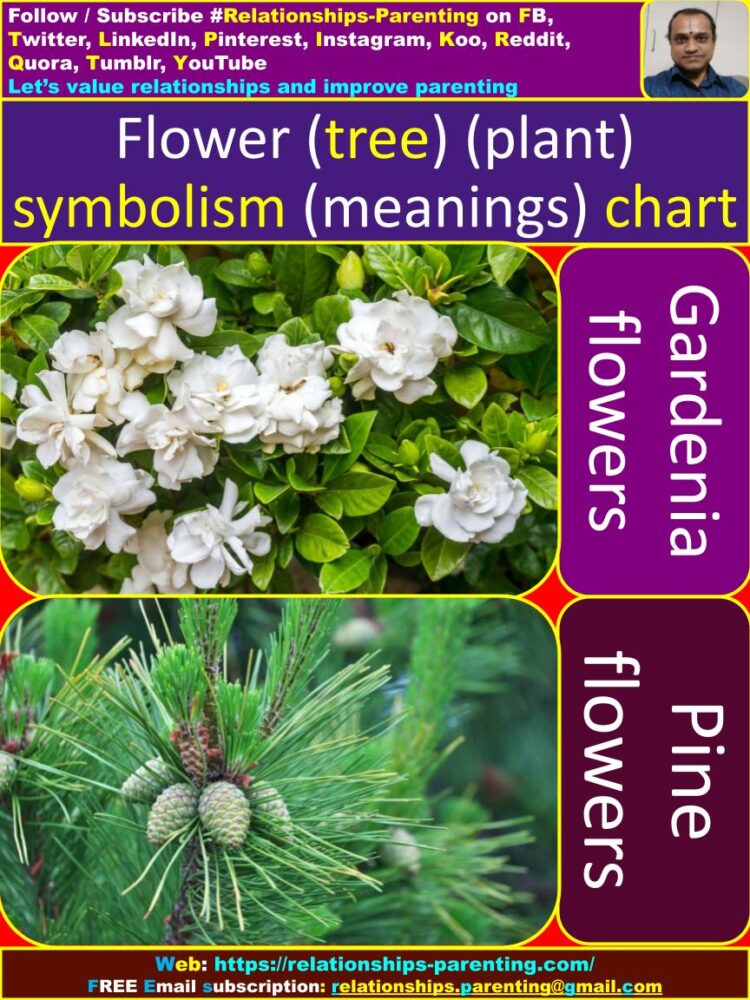
Belladonna : This flower represents silence, quietness, tranquility, noiselessness, peacefulness, still, etc. Belladonna means ‘beautiful woman’ because it was used by Renaissance women to dilate their pupils.
Atropa refers to Atropos, one of the three gods in Greek mythology who determined the sting of a person’s life and their death.
Sorrel : This flower talks about affection, fondness, liking, tenderness, warmness, caring, devotion, friendliness, etc. It symbolizes the cross and the trinity for few cultures.
Earlier it was considered a sacred plant and was sacred to the Druids of Ireland because its leaves formed a triangle.
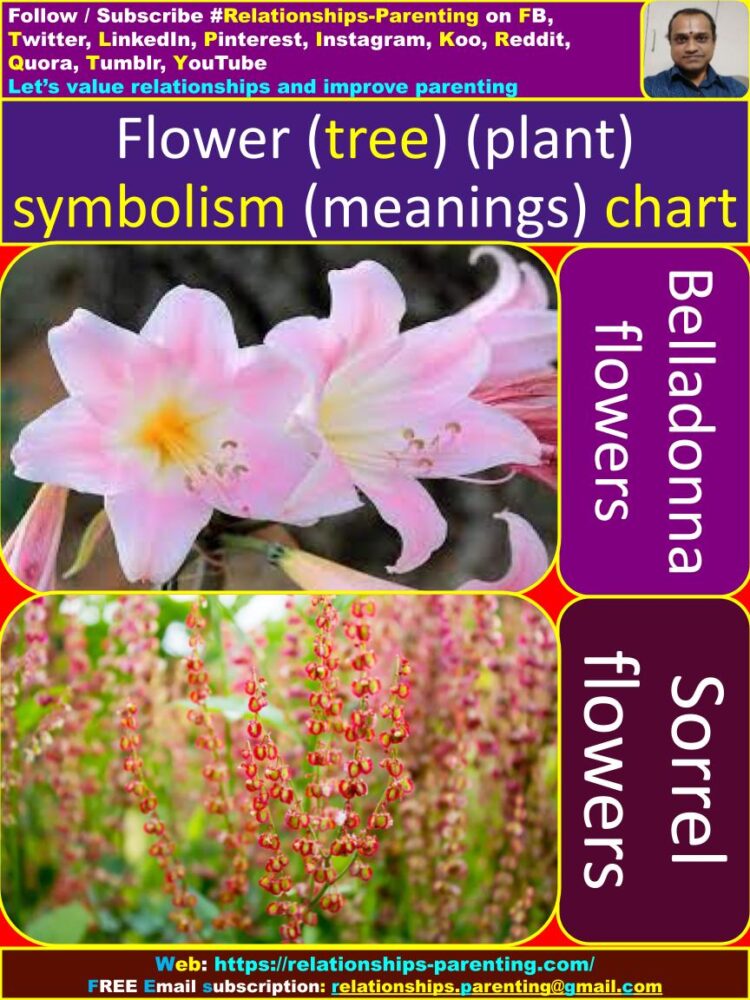
Rue : This flower represents grace, disloyalty, naturalness, neatness, precision, fluency, clear vision, smoothness, etc. Rue is the symbol of infidelity, a symbol of true repentance for all transgressions to women, a symbol of constant suffering, Rue is very bitter.
Poppy : This flower talks about consolation, sympathy, pity, relief, moral support, relief, help, aid, soothing, etc.
Red poppy is symbolizes of both remembrance and hope for a amicable future. Poppies are worn as a show of support for the armed forces community. The poppy is a well-known and well-established symbol, with a wealth of history and meaning.

Oregano : This flower represents substance, solidity, actuality, concreteness, tangibility, corporeality, etc. Literally translated it means “Mountain of Joy” because it covers the hills in the Mediterranean and makes them glow with beautiful fragrances and flowers.
For our purposes, that translation still applies, because oregano is a basic herb that provides olfactory pleasure as much as beauty or aroma.
Morning glory : This flower talks about affection, closeness, warmth, intimacy, amity, favor, respect, regard, etc. The morning glory flower has many meanings, but the most common are love, life and death, or love in vain.
The ability to get up every morning and go to sleep every evening resembles human life. This may seem like a depressing thought; Morning glory blooms every morning only to die every evening.
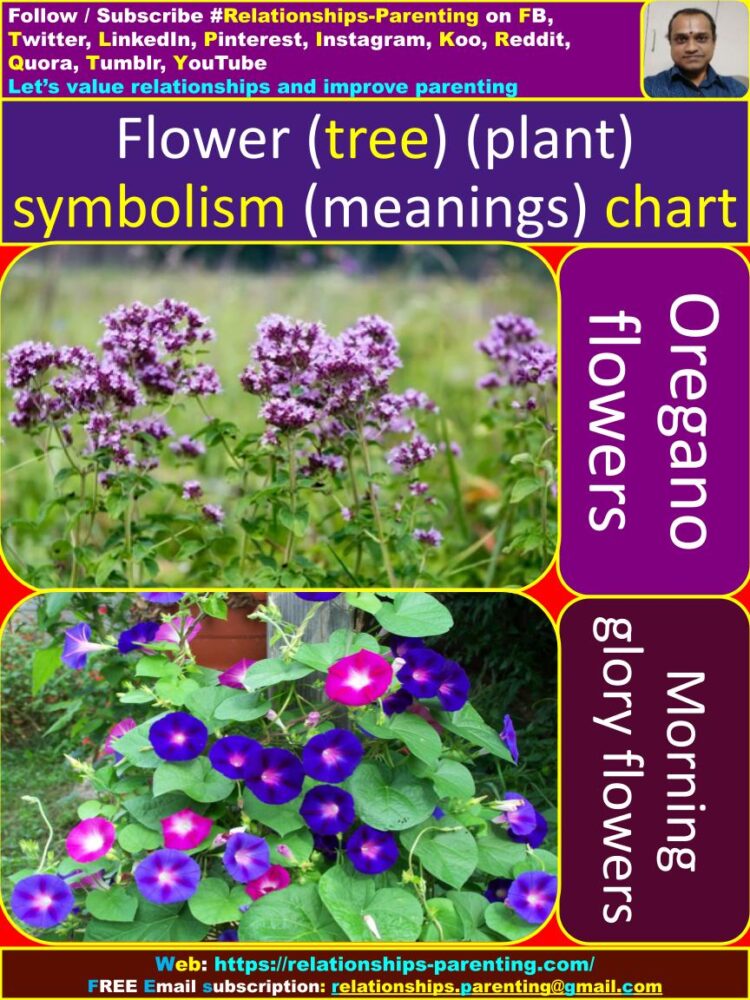
Lemon balm :This flower represents sympathy, solace, pity, support, encouragement, compassion, solicitude, etc. The lemon balm plant has a symbolic meaning of virtue, compassion and empathy.
It has meanings associated with relationships, friendship, healing and healthy boundaries in love. The ancient Greeks valued lemon balm as having a special relationship with bees.
Ivy : This flower tells about affection, attachment, admiration, friendship, harmony, fidelity, good will, etc.
Ivy flower were used to be given to the bride and groom as a symbol of eternal life, devotion, loyalty and faithfulness. The Greeks used it to crown Liber, the god of fertility, and poets and other muses.
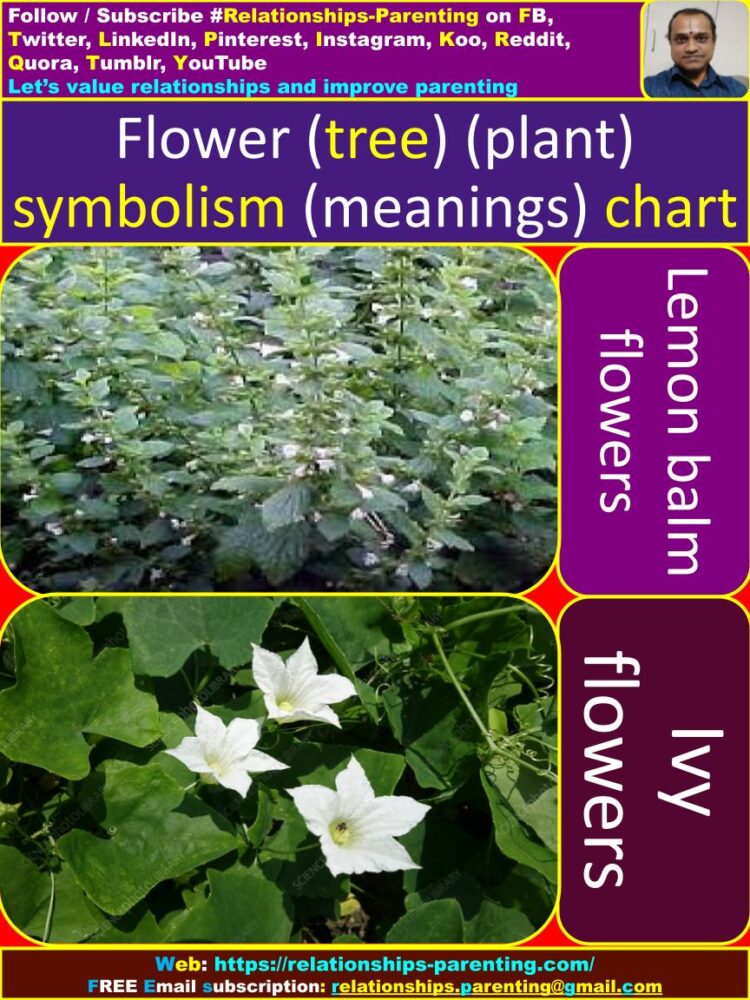
Honeysuckle : This flower represents bonds of love, alliance, attachment, connection, union, coalition, etc. In its simplest form, honeysuckle is a symbol of pure happiness.
In addition, it conveys messages of sweetness and love, thanks to the sweet-smelling aroma it imparts. In its heavier interpretation, honeysuckle represents the flame of love and the tenderness of lost love.
Fennel : This flower talks about flattery, praise, adulation, compliments, wheedling, applaud, etc. Fennel is said to symbolize flattery and adultery. Columbines are for ingratitude, adultery, unfaithfulness or betrayed lovers.
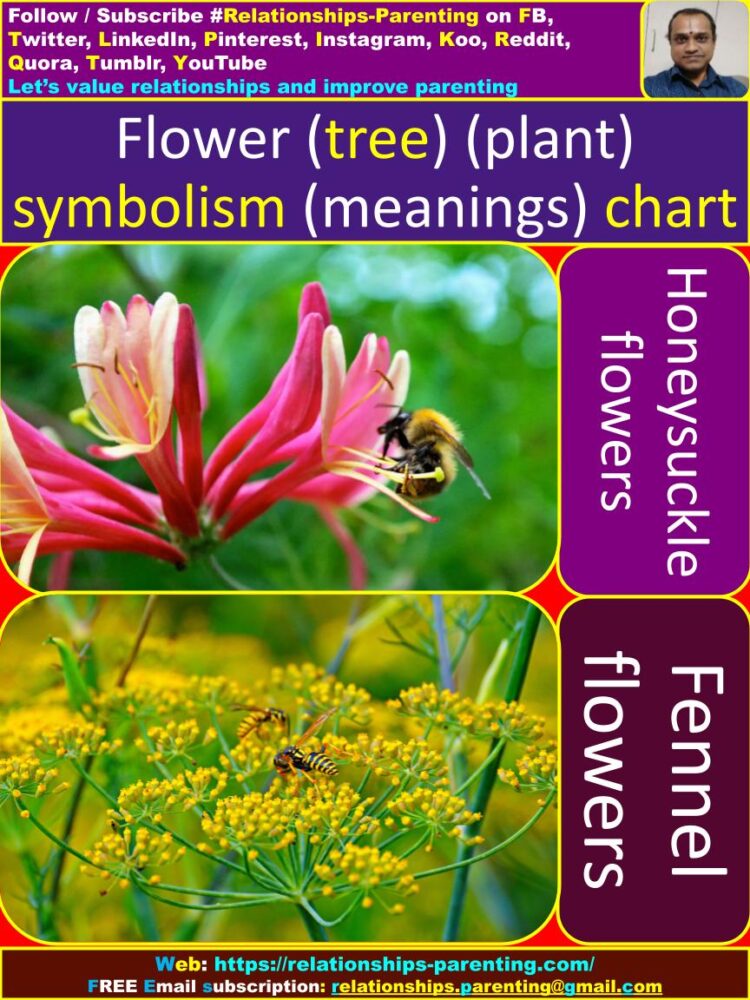
Begonia : This flower tells about beware, cautiousness, be on alert, keep your eyes open, take care, etc.
Begonia stands for awareness and consideration, as well as good communication between different parties. It is usually given as a gift when returning a favor.
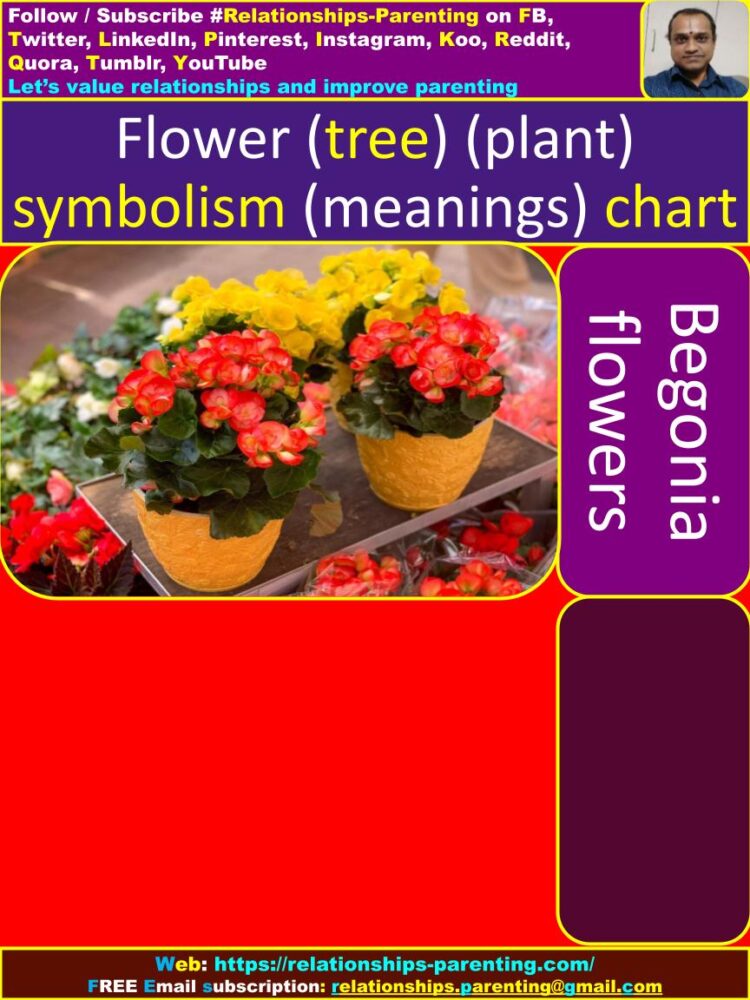
More information will be added to this on regular basis. Please visit this post and blog / website to know more about relationship and parenting.
Continue reading about:
To know more about “Husband and wife information, facts“, please click the below link:
Husband and wife information, facts
Dear friends, if you need any clarifications about this post, kindly let me know, I will definitely try to answer all of them.
Also add your COMMENT below, SHARE on different SOCIAL MEDIA networks.
This will help to know the quality of this content and also it will be helpful to know if any improvements is required for the content.
If you feel this content is useful to you and has helped you to improve your knowledge, kindly share this with your well-wishers.
Because “SHARING MEANS CARING”.
To receive FREE EMAIL SUBSCRIPTION about #Relationship #Parenting, you can send an email to [email protected] from your email ID.
Let you and your well-wishers live a prosperous, healthy and fearless life through out your life term.
Please write on motifs on Hindu deities. Explain cause, importance & significance on each motif.
Utpal Ji,
Will try.